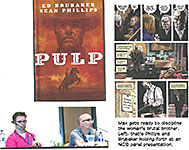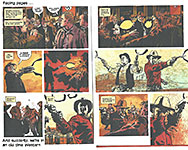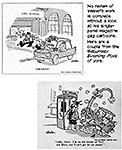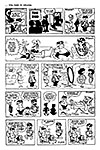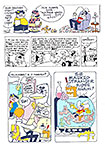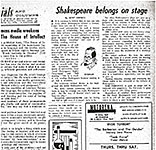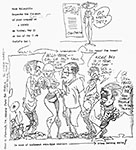 |
||||||||||||||||||||||||||||||||||||||||||||||
Opus 409 (news thru October 27, 2020). The usual array of editoons covering the last month of the Presidential Campaign and unusual comic strips, plus five myths about Stan Lee, Trump and White Supremacy, comic strip anniversaries for Arlo and Janis and for Between Friends, and reviews of Black Heroes of the Wild West, Little Joe, and Brubaker’s Pulp and more. Here’s what’s here, by department, in order (the longest entries are marked with an asterisk* to help you decide where to spend your time)—:
NOUS R US Peanuts Is Seventy Tom Toles Bows Out DC Future State Open Letter on “Philip Guston Now” Rob Rogers Wins Award for Local Editooning 2020 AAEC Awards Sri Lankan Cartoonist Awarded for Courage Archie Thriving History Forthwith: For the Record Five Myths About Stan Lee
FUNNYBOOK FAN FARE Reviews of No.1s—: Negan Lives *Stillwater
THE EVAPORATING EDITORIAL CARTOON *A Modest Proposal by J.P. Trostle
*TRUMPERIES The Antics and Idiocies of Our Bloviating Buffoon in Chief The Election Super-Spreader Killing the Stimulus Relief Bill Trump Denounced White Supremacy (at least twice before) Mitch Wants Power; That’s All Editoons of the Trumpet
**EDITOONERY The Mock in Democracy A Selective Survey of the Month’s Editoons
NEWSPAPER COMICS PAGE VIGIL The Bump and Grind of Daily Stripping Pluggers Changes Creator Taboos and Other Naughtinesses in the Funnies Brenda Starr Is Back!
ANNIVERSARIES Between Friends, 30th Arlo and Janis, 35th
GOSSIP & GARRULITIES Name-Dropping & Tale-Bearing Mae West Wrote Novels —Including Babe Gordon (The Constant Sinner)
RANCID RAVES GALLERY Pictures Without Too Many Words George Lichtenstein (aka Lichty)
BOOK MARQUEE Tall Tales by Al Jaffee Jaffee Issue of Mad Black Heroes of the Wild West
BOOK REVIEWS Critiques & Crotchets *Ed Leffingwell’s Little Joe
BOTTOM LINERS Single Panel Magazine Cartooning Roz Chast in The Comics Journal
LONG FORM PAGINATED CARTOON STRIPS Called Graphic Novels for the Sake of Status *Pulp
Brubaker’s Near-Death Experience Influences His Books
WE’RE ALL BROTHERS, AND WE’RE ONLY PASSIN’ THROUGH Bob Weber Richard Lupoff Kai Shuman
FORTY-FIVE LIFE LESSONS
******
QUOTE OF THE MONTH If Not of A Lifetime “Goddamn it, you’ve got to be kind.”—Kurt Vonnegut
Our Motto: It takes all kinds. Live and let live. Wear glasses if you need ’em.
But it’s hard to live by this axiom in the Age of Tea Baggers, so we’ve added another motto: Seven days without comics makes one weak. (You can’t have too many mottos.)
And in the same spirit, here’s—: Chatter matters, so let’s keep talking about comics. AND—
“If we can imagine a better world, then we can make a better world.”
And our customary reminder: don’t forget to activate the “Bathroom Button” by clicking on the “print friendly version” so you can print off a copy of just this installment for reading later, at your leisure while enthroned. Without further adieu, then, here we go—:
NOUS R US Some of All the News That Gives Us Fits
PEANUTS IS SEVENTY Seventy years ago on October 2, 1950, Peanuts, a comic strip by then-obscure St. Paul, Minnesota, cartoonist Charles M. Schulz, made its debut in just seven newspapers around the world. In the seven decades years since then, Peanuts became one of the most beloved comic strips ever, with it's iconic characters appearing in thousands of newspapers as well as animated films, live stage shows and more. Charlie Brown and his imaginative beagle Snoopy are as familiar sights as Mickey Mouse, another iconic cartoon character. Santa Rosa's renowned Charles M. Schulz Museum and Research Center celebrates the comic strip's Platinum Anniversary and covers other timely topics with a fall season filled with public programs. Due to the Covid-19 pandemic, the Schulz Museum will present the fall season entirely online, meaning Peanuts fans around the world will have the opportunity to join in the fun from the comfort of their own home. Fall 2020 at the Schulz Museum continues in November and December with more drawing classes and live conversations on topics such as the Black experience as told through graphic novels and comics. Advanced registration is required for all online events. Visit schulzmuseum.org to sign up for these events now. For other comic strip anniversaries lately, scroll down to Anniversaries.
TOLES BOWS OUT Eighteen years ago, Tom Toles slipped into the most envied editorial cartooning gig in the country— Herblock’s at the Washington Post. Herbert Block was among a handful of past masters at editooning, and the Post gave him a free hand for 55 years. After he died in 2001, the Post hired Toles to fill the slot. Surprisingly perhaps, given the legend whose shoes he aimed to fill, Toles did just fine, thank you—and became another legend in the process. Now, he’s retiring. The Herblock/Toles spot is open again, and the Post is looking to fill it. The thin ranks of America’s editoonists are doubtless quivering in anticipation. Toles’ last cartoon for the Post will be published on November 1. Whether he’ll return a couple days later for one final exit (in order to comment on the outcome of the Presidential Election) is anyone’s guess. Mine is that he will. Toles’ fifty year career as editorial cartoonist began at the University of New York at Buffalo and The Spectrum, the campus newspaper. After graduation in 1973, he cartooned at the Buffalo Courier-Express for 9 years, then 19 at the Buffalo News, which is where he was when the Post hired him in 2002. Since then, “he has been drawing six trenchant cartoons a week,” one of his editors wrote, saying the paper will “greatly miss Toles’ mordant skewering of environmental malpractice, presidential arrogance and Washington hypocrisies and pomposities of all varieties. Drafting four pencil sketches a day, five days a week, week in and week out, Tom set an almost unimaginable standard of consistent excellence.” He signed his cartoons with his name and, at the lower right-hand corner, seated at a drawingboard, a tiny self-caricature that uttered an ironic comment about the cartoon of the day. Toles
won the Pulitzer Prize for editorial cartooning in 1990 while at the Buffalo
News; and he won the National The Post will not be without an editoonist while looking for a replacement for Toles: “We are fortunate to be able to continue to publish the award-winning work of Ann Telnaes, our other regular cartoonist” (who has won both the Pulitzer and the National Cartoonists Society’s Reuben as “cartoonist of the year”). The University of Buffalo maintains an archive of Toles’ early 1969-1973 work. While GoComics maintains a 25 -year archive of his later 1995-2020 work. And hereabouts, we’ve posted four recent efforts. If you have to enlarge the imagery in order to see and read the miniature Toles in the lower right corner, it’ll be worth your time and effort.
DC FUTURE STATE DC Comics dropped an annoucement of their forthcoming 2021 story arc DC Future State, a two-month event across the DC universe starting in January. The full title lineup will have a combination of monthly and twice-monthly oversize anthologies that give readers a glimpse into the DC superheroes in their future. In this story arc, the Multiverse has been saved from total annihilation, but in the process of saving it, the fabric of time and space was damaged. The final chapter of Dark Nights: Death Metal will kick off this uncanny future storyline. In other words, another fucking scheme to get us to buy every DC comicbook on the newsstand as soon as they appear. I’m confused enough as it is: I don’t need any more multiverses or alter ego superheroines.
OPEN LETTER: ON PHILIP GUSTON NOW (Over the Internet Transome; quoted verbatim here) We were shocked and disappointed to read the news that the National Gallery of Art, Washington, D.C.; Museum of Fine Arts, Boston; the Museum of Fine Arts, Houston; and Tate Modern, London, had postponed by four years their planned exhibition “Philip Guston Now,” which had already been delayed until 2021 by the Covid-19 lockdown. The reason for the postponement? The explanation given by the directors of the four institutions in their announcement expresses anxiety about the response that might be unleashed by certain paintings in which Guston depicts Ku Klux Klansmen, and their preference to “reframe [their] programming and … step back and bring in additional perspectives and voices to shape how [they] present Guston’s work to [their] public.” These institutions thus publicly acknowledge their longstanding failure to have educated, integrated, and prepared themselves to meet the challenge of the renewed pressure for racial justice that has developed over the past five years. And they abdicate responsibility for doing so immediately—yet again. Better, they reason, to “postpon[e] the exhibition until a time” when the significance of Guston’s work will be clearer to its public. The best riposte to the museum directors’ failure of nerve is conveyed by quoting Guston’s daughter, Musa Mayer, as reported in the New York Times: “My father dared to unveil white culpability, our shared role in allowing the racist terror that he had witnessed since boyhood, when the Klan marched openly by the thousands in the streets of Los Angeles. “As poor Jewish immigrants, his family fled extermination in the Ukraine. He understood what hatred was. It was the subject of his earliest works. […] This should be a time of reckoning, of dialogue. These paintings meet the moment we are in today. The danger is not in looking at Philip Guston’s work, but in looking away.” Rarely has there been a better illustration of “white” culpability than in these powerful men and women’s apparent feeling of powerlessness to explain to their public the true power of an artist’s work—its capacity to prompt its viewers, and the artist too, to troubling reflection and self-examination. But the people who run our great institutions do not want trouble. They fear controversy. They lack faith in the intelligence of their audience. And they realize that to remind museum-goers of white supremacy today is not only to speak to them about the past, or events somewhere else. It is also to raise uncomfortable questions about museums themselves—about their class and racial foundations. For this reason, perhaps, those who run the museums feel the ground giving way beneath their feet. If they feel that in four years, “all this will blow over,” they are mistaken. The tremors shaking us all will never end until justice and equity are installed. Hiding away images of the KKK will not serve that end. Quite the opposite. And Guston’s paintings insist that justice has never yet been achieved. In the face of an action such as that taken by these four august institutions, we ask ourselves, as private individuals, what we can do. We can speak out, certainly. But we must do more. We demand that “Philip Guston Now” be restored to the museums’ schedules, and that their staffs prepare themselves to engage with a public that might well be curious about why a painter—ever self-critical and a standard-bearer for freedom—was compelled to use such imagery. That does not permit the museums to fall back on the old discredited stance: “We are the experts. Our job is to show you what’s of value in art and your part is to appreciate it.” It means that museums must engage in a reckoning with history, including their own histories of prejudice. Precisely in order to help take that effort of reckoning forward, the “Philip Guston Now” exhibition must proceed as planned, and the museums must do the necessary work to present this art in all its depth and complexity.
ROGERS WINS NATIONAL AWARD FOR LOCAL COMIC Rob Rogers’ Pittsburgh-Centric comic strip Brewed on Grant in the Pittsburgh Current won the Rex Babin Memorial Award for Excellence in Local Cartooning from the Association of American Editorial Cartoonists. “I was shocked and totally, totally blown away by it,” Rogers said. “I was very honored.” Marc Murphy, a Kentucky cartoonist, was the finalist for the award; see the next report down the scroll. “It’s
truly an honor for the Pittsburgh Current to work with Rob and to
feature Brewed on Grant,” said Current Editor Charlie Deitch.
“Rob has a unique way of talking about what’s going on in Pittsburgh, both the
good and the bad, in a humorous and brutally honest way.” Because of the pandemic, said the Current’s Matt Petras, the judges awarded Rogers through a virtual event. “For decades, Rob Rogers has been a national leader in our profession, deftly satirizing not just national politicians, but also keeping a close watch on Pittsburgh politics and culture,” according to the AAEC judges. “He has been our AAEC president, and he is beloved for his manner and humor. He’s a courageous fighter for our profession, and at a critical moment stood up for his work and right to comment independently.” Brewed on Grant, a strip with musings on local politics and current events, originally ran for more than 20 years in the Pittsburgh Post-Gazette, starting out as black and white and later implementing full colors. After the Post-Gazette’s infamous decision to fire Rogers in 2018, the strip ended until Pittsburgh Current began publishing it in August 2019. The cartoon was also awarded the best in editorial cartooning this year by the Press Club of Western Pennsylvania. “Everybody said, ‘I’m so glad to see this back,’” Rogers said. “I had several people request copies of different ones.” Being awarded for local cartooning is especially exciting for Rogers because of the value he believes local cartooning has. “The cliche is that all politics are local, but that is really truly where changes can be made and where people’s lives are affected, is on the local level,” Rogers said. “I think it’s really important to have checks and balances on that level to keep a check on the people in power so that corruption doesn’t happen. “I really do think that we cannot underestimate the importance of local coverage.” (I think he means “overestimate.”—RCH)
2020 AAEC AWARDS The Association of American Editorial Cartoonists makes three awards each year, and usually joins with the Cartoonists Rights Network International in presenting a fourth one, the Courage in Cartooning Award. Here are this year’s winners—: The AAEC/John Locher Memorial Award to a student cartoonist for creativity in editoiral cartooning— Congrats to Catherine Gong! Catherine is a graphic designer, illustrator and cartoonist based in San Francisco who says that, in her covert rebellion against prejudice, her weapon of choice is satire. The 2020 judges said: “Catherine’s work demonstrates a range of commentary from strong and poignant to precise and funny, all skillfully drawn with a unique voice.” Cartoonist Tom Coute was named runner-up, and Emeka Perkins-Johnson, Sam Nakahira and Edward Wilson were also cited for their notable submissions. The AAEC Ink Bottle Award presented annually by the President of the AAEC “in recognition of dedicated service to the Association and distinguished efforts to promote the art of editorial cartooning”— This year’s recipients are Adam Zyglis, Ed Hall and JP Trostle, the trio of cartoonists who labored for several years to revamp the AAEC’s website, and update the look of the 64-year-old professional organization for the 21st century. The Rex Babin Memorial Award Excellence in Local Cartooning — Rob Rogers’ win is reported in the preceding story. Kentucky cartoonist Marc Murphy was named the finalist. Presented by Jack Ohman, JD Crowe, Kevin Kallaugher, the three judges had this to say about the finalist: “Marc
Murphy is a trenchant, sophisticated observer of Louisville and Kentucky,
and his work appears regularly in the Louisville Courier Journal—when
he’s not a practicing attorney and former elected official and activist. Marc’s
cartoons are The Robert Russell Courage in Cartooning Award — And last but not least, the AAEC is proud to stand with the Cartoonists Rights Network International in its choice for the 2020 Courage in Cartooning Award, Ahmed Kabir Kishore. More from CRNI Director Terry Anderson in the following report.
SRI LANKAN CARTOONIST AWARDED FOR COURAGE The Cartoonists Rights Network International presented its 2020 Courage in Cartooning Award to Ahmed Kabir Kishore. CRNI Director Terry Anderson had this to say in presenting the award: “Ahmed is a cartoonist and activist known to CRNI for over a decade. He campaigned bravely on behalf of the disappeared Sri Lankan cartoonist Prageeth Eknaligoda and jailed Bangladeshi cartoonist Arifur Rahman and identified as a CRNI ‘affiliate leader’ in the country, although doing so inevitably made him a target for accusations of aligning with foreign interests. This speaks to his courage, as do his public demonstrations for the human rights not only of cartoonists but also Hijra people and in defense of health and consumer rights and the Bengali language. “Through April and into May of this year Ahmed posted to Facebook a series of cartoons he entitled ‘Life in the Time of Corona,’ satirizing society’s response to, and critical of the government’s handling of public health during the pandemic.” “On May 5, 2020, Ahmed was among several people arrested under the Digital Security Act by personnel from the Dhaka division of the Rapid Action Battalion (RAB-3), the unit officially deployed against terrorists, drug lords and human traffickers but often accused of being an instrument of government suppression. Lawyers at the Ain-O-Shalish Kendra (ASK) legal aid organization have seen the charge sheet and tell us that Ahmed is alleged to have taken part in a ‘conspiracy, spreading rumors and misinformation against the prime minister Sheikh Hasina and her late father, Sheikh Mujibur Rahman.’ Ahmed is alleged to be an administrator on a Facebook page called ‘I am Bangladeshi,’ which is considered as the main subject of investigation by the authorities. “In the ensuing months of detention Ahmed has been denied a bail hearing on three occasions and subjected to periods of what’s described as ‘jail gate interrogation,’ this despite the ongoing and imminent threat to prison populations posed by corona virus COVID-19 and the release of literally thousands of criminally prosecuted people from jail in Bangladesh for precisely that reason. Ahmed is an insulin-dependent diabetic, meaning he should be afforded some extra protection from infection. “CRNI has petitioned the prime minister on Ahmed’s behalf along with ASK, Cartooning For Peace, Forum for Freedom of Expression, Bangladesh (FExB) and Reporters Without Borders. Our request for clemency has been ignored. “The intent of the Robert Russell Courage in Cartooning Award is to recognize the plight of a cartoonist experiencing a human rights violation — and in our view that is precisely what has happened to Ahmed, several times over — as well as raise their profile in the hope that doing so will help bring about a favorable resolution. 2020 has been an extraordinarily, exceptionally bad year. “We could have presented the ‘Robert Russell’ to European cartoonists whose censure was requested by Chinese diplomats, to a Jordanian cartoonist arrested for caricaturing the crown prince of the UAE, Brazilian cartoonists harassed by law enforcement, an Algerian cartoonist detained for ‘disrespecting’ the military or a Palestinian cartoonist subjected to mass internet trolling and death threats over a cartoon to which Saudi Arabians took offense. “Circumstances have been so bad that we were forced to make an emergency statement in the spring, warning that lasting and potentially irreparable damage would be done to the global community of cartoonists in 2020, due in large part to the license the pandemic has granted to authoritarian regimes. “Therefore Ahmed Kabir Kishore’s case is emblematic of the times in which we live; his freedom to express skepticism and dissent has been violated and that in itself would be sufficient to attract our attention, but for the last six months his life has been needlessly put at risk by detention in jail – universally recognized as an environment where corona virus is a higher risk – and despite his health condition – again, universally recognized as a contributing factor to illnesses such as COVID-19 “In presenting the Robert Russell Courage in Cartooning Award 2020 to Ahmed Kabir Kishore, we call for his immediate release, his total exoneration of all criminal charges and an independent investigation into his treatment while a detainee.”
ARCHIE THRIVING By Newsarama Staff Twenty-twenty has been a year no one expected, including Archie Comics. But they've rolled with the proverbial punches, and have made several announcements in the final months of 2020 as they prepare for Archie's 80th anniversary in 2021. In the past 30 days, they have: ● Made a deal for all their comics to debut day-and-date on comiXology Unlimited as it will in comic stores. ● Partnered with Webtoon to begin original Archie webcomics on the platform. ● Signed a deal with Spotify for a series of audio drama podcasts. ● Amazon Prime Day deals: see all the best offers right now! While its flagship title Archie remains on hiatus, the publisher has already made plans to resume the publication of new Archie Comics through the end of 2020 and into 2021. With everything going on, Newsarama reached out to Archie Comics' co-president Alex Segura to get a big picture look at the company, its plans, the impending 80th anniversary, and the hiatus of the main Archie title. What follows, Segura’s remarks culled from the interview with him—: The mentality during those early days of the shutdown was to hang on and be flexible. We tried to do the best we could, make sure we were putting out product that could entertain and distract during these extremely difficult times. ... Yes, Diamond is back and we're thankful for that, and we're extremely grateful to the comic shop retailers who are engaging with customers and selling the books we create. Running a comic shop has never been an easy job, and we're all blown away by their passion and perseverance during these unprecedented times. ... In terms of challenges— we have to be more judicious than ever before. ... It doesn't mean we don't take flyers: I think anyone can see that Archie, at least over the last decade under Jon Goldwater's leadership, has been all about taking risks and realigning how people perceive our iconic library of characters. So, the idea has been to spread out the publishing slate we'd planned for 2020, and let some of those books roll into 2021, with an eye toward back-checking those launches and making sure we're confident and comfortable before moving ahead. We're also rethinking how we engage with our backlist. We have almost 80 years of content, with new material being scanned and remastered every week. ... We've simultaneously expanded into new markets and retailer outlets that were previously unavailable to us— places like Costco or grocery store chains that hadn't stocked some of our products before. We continued to supply products through our webstore, selling directly to fans, and created new digital exclusive material to fill in some of the gaps in the schedule that opened up. We began publishing free stories on our social media pages which helped brighten the days of many fans during a difficult time. We had to think about how to serve our various readerships in ways that allowed us to stay nimble and responsive to not only the direct market, but publishing and distribution as a whole, and I think we did that well— it's a testament to how we came together as a company to stay focused and moving forward. Asked when he foresees returning to a schedule with more new, original material, ala prior to the April shutdown, Segura responded—: You're seeing it start to ramp back up already ... We just released our first-ever original graphic novel, Betty & Veronica: Bond of Friendship, in comic shops and bookstores last month. That right there is the new content equivalent of a five-issue mini-series, and we have an all-new Riverdale OGN launching in February. ... A new Madam Satan one-shot is launching in just a couple of weeks that we're very excited about, and that was in the works prior to the shutdown. During our New York Comic Con panel, we announced a new Riverdale Presents: South Side Serpents one-shot and two new digest series which will feature extended new lead stories in their debut issues. And new lead stories in the 'classic' Archie style are returning to our digest publications beginning this week. All of these decisions were made months ago - it just takes time to start to get things back in motion and out the door - especially now with a remote workforce. ... Archie is our longest-running series, and to many our flagship. ... We pivoted and did a "series of mini-series"— with Archie and Sabrina— followed by Archie and Katy Keene, all under the umbrella of the ongoing Archie book, but still with clear, Number-One-like jumping-on points for readers. That did well enough for us, but not so well that we felt confident riding out the shutdown publishing new issues. The end of Archie and Katy just dovetailed with the Diamond shutdown, so it gave us a minute to rethink and re-tool. There was a project that we had slated in for this summer that would have fit in this spot very nicely but we had to reschedule it. We'll have a few major announcements relating to the mainline Archie series fairly soon— keep an eye on this as we head into the new year. ... Next year is Archie's 80th anniversary, so you'll see a lot of content geared toward that— celebrating the past but also pointing to the future. Our new Archie 80th Anniversary Digest and World of Betty & Veronica Digest series are a part of that. ... We'll have a major, Archie-centric announcement in the coming months, plus some news on other properties that I can't get into now. Additionally, we'll continue our Archie Blue Ribbon line of original graphic novels with Riverdale: The Ties That Bind, by writer Micol Ostow and artist Thomas Pitilli, a new Riverdale Presents: South Side Serpents one-shot by David Barnett and Richard Ortiz, and a few other surprises. In addition to that, we just announced our partnership with Webtoon and that we'll be creating new comics content specifically for their platform in 2021. We're also building and expanding on the great successes we've had with current partners like Scholastic and Little Bee, who've brought greater awareness to our amazing characters in the YA and children's book markets. There's a lot to look forward to in 2021 and I'm eager to see how people respond to it.
History Forthwith: FOR THE RECORD Modern comics scholarship began, I believe, with All in Color for a Dime (1970) by Dick Lupoff and Don Thompson although an excellent case can be made for Jules Feiffer’s The Great Comic Book Heroes (1967); and, shortly thereafter, Jim Steranko’s Steranko History of Comics in 2 volumes (1970, 1972). The cluster of useful scholarship accumulated around the end of the 1960s and the early 1970s. The Penguin Book of Comics by George Perry and Alan Aldridge came out about then (1967 revised in 1971). Meanwhile, Reinhold Reitberger and Wolfgang Fuchs were at work in Germany on Comics: Anatomy of a Mass Medium, which was translated into English and published in this country in 1972. That same year, The Art of the Comic Strip, a collection of essays edited by Walter Herdeg and David Pascal, appeared. After which came Arthur Asa Berger's The Comic Stripped American (1973), followed by Ron Goulart's Adventurous Decade (1975). Then came a special comics section in the Journal of Popular Culture, Spring 1979—a collection of essays edited by M. Thomas Inge. I’m leaving out a couple of books that were essentially reprints of strips and/or comicbook stories without much scholarly text. The 1980s were barren, oddly—considering so much was happening in comicbook publishing (maturing stories and characters, new publishers, including alternatives). Not much happened until—: Comics as Culture (1990) by M. Thomas Inge The Art of the Funnies (1994) by Robert C. Harvey The Art of the Comic Book (1996) by R.C.H. Comics, Comix & Graphic Novels: A History of Comic Art (1996) by Roger Sabin All of which is just for “the record.” I was attending a scholarly session at a convention a couple years ago, and one presenter recited the history of comics scholarship by listing early authors of comics-related tomes. I don’t remember that any of the people or works I just cited were among those he mentioned. Maybe Jules Feiffer and Jim Steranko. But probably not Lupoff and Thompson. Okay: I’m miffed because I was also overlooked. But more significantly, Tom Inge wasn’t mentioned. And he’s responsible for more comics scholarship than just about anyone. He was (and still is) consulting with the University Press of Mississippi and urged me to submit something—hence, both of my books above. (Which were submitted to the University Press as one book; they said it was too long for one book, and so it was published as two.) So you could say that of the thirteen earliest scholarly books on comics, Inge was responsible for four of them. That’s thirty percent. Someone should take note of that. For the record.
FIVE MYTHS ABOUT STAN LEE Scandal by Abraham Riesman, Washington Post Riesman is a journalist and the author of True Believer: The Rise and Fall of Stan Lee, set to be released by Penguin Random House on February 16, 2021. In the following article, Riesman proves once again that all it takes is the death of some notable for the notable’s envious critics to come out from under the rocks where they usually dwell and smear the notable about whom the critics were too timid to assault while he lived. Here’s Riesman—: Stan Lee gained renown for co-writing and promoting the Marvel line of comic books in the 1960s, then went on to sell himself as a brand and media personality until the day he died, just shy of his 96th birthday. But as beloved as he is, his life and work are often poorly understood.
Myth No. 1 — Lee created the Marvel Universe. Lee has long been credited as the driving force behind the pantheon of Marvel superheroes that took the world by storm: Spider-Man, the Avengers, the X-Men, Black Panther and so on. His obituaries from news outlets such as NBC News and Reuters all characterized him as the comics’ “creator.” Others (such as The Guardian) that are a little less expansive with bestowing credit on him will say he co-created the characters with writer/artists Jack Kirby and Steve Ditko. There is actually zero evidence that Lee had the initial ideas for any of these characters, other than his own claims. In his 2002 memoir, for instance, he said of Ditko: “I really think I’m being very generous in giving him ‘co-creator’ credit, because I’m the guy who dreamed up the title, the concept, and the characters.” The world has generally accepted that Lee had the initial notions for the characters, only then passing them off to Kirby or Ditko. But over the course of legal cases, painstaking historical debate and my own archival research, nothing has ever been turned up that proves — or even suggests — that Lee was the driving creative force. No presentation boards, no contemporary notes, no diary entries, no supporting accounts from anyone other than his wife. Nothing. (Maybe it’s a mistake to look for documentary evidence in such matters, particularly in the deadline-driven catch-as-catch-can creative world of comicbooks.—RCH) Meanwhile, Kirby and his defenders have asserted that Kirby was the characters’ sole creator, accurately pointing out that he had a far longer history of creating successful characters on his own. Same goes for Ditko. Because of the fly-by-night record-keeping practices of the mid-century comic-book industry, it’s unlikely that we’ll ever have a firm answer. But companies, journalists and historians can’t say with any certainty that Lee created (or even co-created) Marvel’s dramatis personae.
Myth No. 2— Lee loved comics and superheroes. Countless people take for granted that Lee was personally enthusiastic about comics. Geekdom and conventional wisdom assumed so; even the Library of Congress has characterized him as “Comics’ Champion.” He did perpetually talk up the power of comics, probably bolstering the perception that he was a fan: “Superhero movies are like fairy tales for older people,” he told The Washington Post in 2011. “I don’t think they'll ever go out of vogue.” According to private accounts from his archives and the words of those who knew him, Lee really couldn't stand — and didn’t read — comic books. In conversations with creatives such as Alain Resnais and Francis Ford Coppola, in his memoir and even in speeches to his colleagues, he spoke at length about how he had no innate love for the medium and had merely taken it up through happenstance. It was just a hustle for him, one he repeatedly tried to escape through schemes to make it big in movies, poetry, even encyclopedias. He spent much of his post-’60s career trying to pitch non-superhero ideas in various non-comics formats. According to his former manager and his former bodyguard, he loathed superhero movies and probably saw only about two of them in his life. (He typically left their premieres after walking the red carpet.) (So he didn’t like comicbooks. That’s no big deal.—RCH)
Myth No. 3— Lee wrote the comics he published at Marvel. Lee was nearly always credited as “writer” in the credits of his comics, with his writer/artists listed as “artist.” Examples abound of the public accepting this categorization, including in serious-minded outlets such as The Economist and New York magazine. But the publishing company produced comics through a strange process now known as “the Marvel Method,” whereby, typically, Lee would have a conversation of some kind with his writer/artist to discuss a few ideas. The writer/artist would take that prompt and write the story in visual form by drawing the pages and placing clarifications and dialogue suggestions in the margins. After that, Lee would add the dialogue and narration. He virtually never wrote actual scripts. And tossing around concepts with a writer/artist is the task of an editor, not a writer. (Sorry: I disagree. Admittedly, the artists did more “storytelling”—the usual function of a writer—than is commonly supposed. But that doesn’t mean Lee didn’t also function as a writer.—RCH.) Given that the writer/artists — most notably Kirby and Ditko, but also such titans as John Romita, John Buscema, Wally Wood and Don Heck — actually constructed the story, they should be considered the true, primary writers, with Lee doing embellishment (however crucial such embellishment may have been to the work’s success).
Myth No. 4— He was a political progressive. Left-leaning Marvel fans have often held Lee up as a hero for those who seek to fight inequality and bigotry, calling him a “progressive genius” and a “true ally for people of color.” Some point to the occasional moments when he would write short editorials vaguely decrying racism. Others offer interpretations of his heroes as underdogs who represent the downtrodden — particularly the X-Men, who have often been taken as allegories for Black or queer people (despite Kirby and Lee both saying they were primarily just a sci-fi concept about mutation). Lee couldn’t be called right-wing, but his politics had a conservative bent. He often wrote and spoke about how reactionaries and radicals were equally wrong and privately complained about how taxes in America were too high. In the midst of the anti-establishment riots of 1968, he convened a panel for a failed talk-show pilot in which he repeatedly denounced radicalism; asserted that Black people needed to respect the law; and said the Vietnam War may have been immoral, but had to continue for the greater good. These ideas were of a piece of the way he’d depict the hot issues of the day in the comics he co-wrote, particularly in stories about Spider-Man and Captain America confronting campus protests: They always featured good guys on both sides who succeeded by meeting in the middle. (So, he wasn’t just an “embellisher” after all: he was a co-writer.—RCH) And, of course, the vast majority of the characters he wrote for were white and male. All of this should give people pause when they tout him as a champion of the progressive politics of 2020. (For people of Lee’s generation, to be a “conservative” was not so much KKK as it is now.—RCH.)
Myth No. 5— Lee made a lot of money from Hollywood. Given that Marvel film and television adaptations have made tens of billions of dollars and that the company names Lee as one of the co-creators of the intellectual property underlying the franchise, one can be forgiven for assuming — as outlets such as the Daily Star and Playboy have — that Lee took home a huge chunk of that cash. “Did you at least get a [Tony] Stark-like helicopter in the deal?” an interviewer asked, after Disney bought the comics publisher. As a 2014 article in Comics Alliance observed, Lee often “worked hard” to project an image of himself as “a tremendously wealthy comic book mogul primarily responsible for the success of some of Marvel Comics’ most iconic — and profitable — superhero characters.” But Lee earned only a day rate for filming his cameos. Although Lee died with wealth (we should hesitate to estimate his exact net worth, but he claimed it was well below $100 million), much of it accumulated through various contracts with Marvel over the decades, it didn’t stem from film and television projects. Lee didn’t actually own Marvel Comics — it was created by his cousin-in-law Martin Goodman and went through a long succession of corporate parents, culminating in Disney today. Even more shocking, he didn’t have any ownership of the characters he was credited with creating. One of the great injustices of the comic-book industry is that the biggest publishers, Marvel and DC, treat their writers and artists as freelancers who do work for hire, and thus typically cede all rights for the characters they create to the company. As a result, Lee’s fortune was a microscopic fraction of the revenue that Marvel generated. (Well, then—where did Lee get all the millions he’s supposed to have in the bank? No one has assumed that he made a fortune with cameo roles in superhero movies. I thought he did ’em for free and for fame. As I understand it, once the Marvel movie industry got underway, he successfully re-negotiated his deal with Marvel so he’d get a suitable share of the revenue. But what do I know? Probably not much more than Reisman.—RCH)
ODDS & ADDENDA Kamala Harris’ life story is getting the comicbook treatment. TidalWave Comics is proud to announce the addition of Kamala Harris comicbook to its popular “Female Force” series focused on female empowerment. Female Force: Kamala Harris was released on October 21st in time for her birthday. In the fourth issue of Image’s Adventureman, the title character actually shows up—a remarkable occurrence because he and his adventures are entirely imaginary in the mind of, say, Claire, the hard-of-hearing bookshop owner. And the other remarkable thing about this issue is that it devotes two pages in the back to telling people how to register to vote (and listing the deadlines of every state). Yes, remarkable. Rob Stolzer, who teaches art in college and has been collecting cartoon works for 40 years (it sez here), has a great blog at inkslingers.ink/blog/. Among the postings are a couple of Bud Blake (Tiger) demonstrations of visual comedic genius (including pencil roughs) and a pre-Wonder Woman history of H.G. Peter, whose cartoons for the old humor magazine Judge (1881-1947) do not at all suggest the style he deployed later in comic books.
Fascinating Footnit. Much of the news retailed in the foregoing segment is culled from articles indexed at https://www.facebook.com/comicsresearchbibliography/, and eventually compiled into the Comics Research Bibliography, by Michael Rhode, who covers comic books, comic strips, animation, caricature, cartoons, bandes dessinees and related topics. It also provides links to numerous other sites that delve deeply into cartooning topics. For even more comics news, consult these three other sites: Mark Evanier’s povonline.com, Alan Gardner’s DailyCartoonist.com (now operated without Gardner by AndrewsMcMeel, D.D. Degg, editor); and Michael Cavna at voices.washingtonpost.com./comic-riffs . For delving into the history of our beloved medium, you can’t go wrong by visiting Allan Holtz’s strippersguide.blogspot.com, where Allan regularly posts rare findings from his forays into the vast reaches of newspaper microfilm files hither and yon.
FURTHER ADO Here’s one to remember from a woman who posted it on her Facebook page: My dad died of Covid less than two weeks ago. He did not have access to a team of doctors and nurses or a helicopter at his beck and call. (And you won't either) He was not given experimental treatments and the best care in the country. If the president gets worse he will be able to have his family suited up in the same protective gear that healthcare providers wear to be with him, my father got to see us for a few minutes a day on Facetime. Both my husband and I also had Covid. I had a fever for 3 days and suffered from fatigue for much longer. Scott had a fever for more than 10 days, his oxygen levels started to dip low enough that I thought I would have to take him to the hospital. Luckily it didn't come to that. A month later and he is still tired and has a cough. I am angry that this president is making it seem that you can beat this virus if you are just determined enough. I agree that you should not be afraid of Covid, but you still need to take precautions, wear a mask, wash your hands and if you test positive don't take your infectious, mask-less ass out in public to infect others.
FUNNYBOOK FAN FARE Four-color Frolics An admirable first issue must, above all else, contain such matter as will compel a reader to buy the second issue. At the same time, while provoking curiosity through mysteriousness, a good first issue must avoid being so mysterious as to be cryptic or incomprehensible. And, thirdly, it should introduce the title’s principals, preferably in a way that makes us care about them. Fourth, a first issue should include a complete “episode”—that is, something should happen, a crisis of some kind, which is resolved by the end of the issue, without, at the same time, detracting from the cliffhanger aspect of the effort that will compel us to buy the next issue. A completed episode displays decisive action or attitude, telling us that the book’s creators can manage their medium.
TO THE BEST of my knowledge, I never—not once, not ever—looked at anything Walking Dead. So the name of this comic book, Negan Lives, held no special meaning for me. In fact, the name Negan had no special meaning for me until after I’d read the book and enjoyed it, and, at the end of it, read an epilogue by the book’s writer, Robert Kirkman, in which he explains why he didn’t kill Negan off, as he’d planned to, in No.174 of The Walking Dead. I’m glad I didn’t know Negan was a character of Walking Dead renown because had I known that, I wouldn’t have bought the book and I would therefore have missed one of the most promising first issues around. As it happens, I bought the book because the cover intrigued me. Just the picture, not the name Negan. We encounter Negan as he picks flowers and talks to them for the first couple pages. It then emerges that he is apparently all alone by himself, the sole survivor perhaps of something that has killed his wife and everyone else in the world. And then this cute chick shows up. He soon realizes that she’s up to no good—and, right enough, two thug show up and try to kill Negan. He resists. So successfully that he kills them. (Well, one of them is killed by a couple of the walking dead, who show up and completely surprised me.) This episode shows that Kirkman and his illustrator, Charles Adlard, know how to develop both story and episode. It also reveals that Negan is no slouch.
What Negan will do in a world without much human populace except walking dead people, I dunno. But it’s a provocative premise, so I’ll go along Adlard’s drawings—all in black-and-white with gray tones—are crisp and clean and pleasant to look at. And he and Kirkman repeatedly demonstrate storytelling chops with pacing and panel composition, relying several times on silent (wordless) passages, the presence of which is almost always a tip-off: these guys understand the medium and deploy its capabilities expertly.
DANIEL WEST JUST GOT FIRED, so no one, certainly not his friend, Tony, who buys drinks for him, thinks the less of him for getting drunk. And then he gets a letter from a law office, telling him that he’s inherited money from a great grand aunt he never heard of. The letter doesn’t tell Daniel how much money, so he takes Tony with him, and they drive to the town where the law office is, Stillwater, hoping to find out more about his fortune there. Writer Chip Zdarskky names this comic book after the town Daniel and Tony drive to. And with good reason, as we soon learn. They stop for gas en route, and when they ask the station operator about Stillwater, she apparently has never heard of it. Since the town is only an hour away, that seems odd. But that’s not the end of odd with Stillwater. When they get to the town, they visit a diner to eat, and the waitress there says the lawyer they’re looking for hasn’t lived there for fifteen years. While they’re talking, Tony looks out the window and sees two kids on a rooftop, one of whom shoves the other off the roof, and the kid falls a couple stories to the ground. Daniel and Tony run out to attend to the kid, find he’s still alive, and take him to a doctor’s office on the corner. There, the kid miraculously recovers and abruptly leaves the premises. Daniel dashes out in pursuit, but the kid has disappeared. He roughly asks a citizen if he’s seen the kid. This attracts the attention of the local cop, but Daniel is having none of it: he takes a swing at the cop, who belts him in return, then breaks his arm. Summoning help, the cop and his helpers take custody of Daniel and Tony and take them out of town, to where one of the cop’s minions has built a huge fire. “I’ll kill you!” Daniel shouts in exasperated fury. “You can’t kill me,” the cop says. “You can’t kill any of us. I mean, you can out here—but past that fence,” he gestures back toward the town, “—in the borders of Stillwater? My home? Nobody dies. And I aim to keep it that way,” he adds, taking out his revolver. “But out here?” And he puts the muzzle of his gun up to Tony’s forehead and shoots. Just as he’s about to do the same with Daniel, a woman drives up, jumps out of her car, and yells, “Wait!” She runs up to Daniel and grabs his face. “My boy,” she says, “—you’re back, you’re back.” End of book. So Stillwater is a weird town within the borders of which no one dies. Remember the kid who fell off the roof? He’s fine.
Provocative enough for me. I’ll be back. Ramon K. Perez turns Zdarsky’s tale into imagery with a breezy, flexible line, and the two of them display a mastery of the medium, energetically pacing the action by changing the focus from panel to panel. The opening sequence with Daniel getting drunk twice shows our authors understand how to tell a story. Perez also draws the gun blast that kills Tony with visual aplomb and an able assist from colorist Mike Spicer.
QUOTES & MOTS
The recent demise of the new material print magazine was, he says, “mission accomplished. You know, there wasn’t much more it could do.”
THE EVAPORATING EDITORIAL CARTOONIST By J.P. Trostle Ever find something you completely forgot you drew or wrote? Tonight I went looking for an article I wrote some 15 years ago and — with the alt-weekly's site long obliterated — had to pull up the html files of a defunct personal site from a backup drive. In the folder was also a piece on editorial cartooning that I have no memory of writing. The fact that it never appeared in print might have something to do with that. The circumstances around it's creation are a bit muddy as well, but it is clear the Los Angeles Times quoted me in an news item [when Michael] Ramirez left the paper, and I felt the urge to respond. In retrospect it's a fairly shameless rip-off of Jonathan Swift — and it's obvious why the LA Times never ran it. But hey, you might find it, uh, amusing.
A Modest Proposal [The following was a guest column written for the Los Angeles Times in November 2005. It got killed at the last minute however, and never ran ... gee, I wonder why?] Two weeks ago, in an LA Times article announcing the axing of editorial cartoonist Michael Ramirez, several statistics from a piece I had written for Nieman Reports about disappearing cartoonist jobs at newspapers nationwide were cited. I had considered responding to the news at that time, but the outpouring of outrage and annoyance from readers said much of what I wanted to say. I might have included a few additional statistics, such as that numerous reader surveys in recent years have consistently placed the editorial cartoon, particularly by a paper's own staff cartoonist, as one of THE top items readers look for, or that in 2005, during a period when newspapers were hemorrhaging subscribers, one of the few papers in the country to actually grow in circulation was the News & Observer in Raleigh, North Carolina— and they added TWO MORE cartoonists to their roster this year. (A coincidence? I'll leave that up to you.) I could have asked what the Los Angeles Times intended to do with the space formerly occupied by the editorial cartoon. Did they really think an additional 12 column inches of text — the equivalent of one more letter to the editor, or, 250 more words by, say, a Jonah Goldberg— would have anywhere near the visceral impact or insight of a single Ramirez cartoon? Will simply providing more words stop the stampede of readers to other media? Or did they intend to use that open space to sell advertising? In many ways, this recent decision does come down to money (as Ramirez himself mentioned in the November 11 article), but does management believe they can keep up the paper's double-digit profits by getting rid of big name staff members? Does the Tribune Company, which owns the Times, really think that trimming the salary of a cartoonist will help them pay off the nearly $1 billion they may owe to the IRS? Apparently so. In the last two weeks, the Tribune Company has given take-it-or-leave buyout offers to at least two other staff cartoonists at prominent newspapers it owns, and are considering giving the same to three more [destined to depart] as part of a chain-wide reduction in newsroom employees. And as at the Times with Ramirez, it is widely considered these editorial positions will be eliminated entirely. Since it is clear now that the Tribune is targeting cartoonists, I would like to make a modest proposal. Sure, they can save some money by firing Ramirez and the others, but that's shortsighted; they're only using part of what editorial cartoonists have to offer. Do you have any idea what organs bring on the black market these days? A good heart and set of lungs can easily get you 50 grand. While our spleens may be shot from overuse, kidneys, livers and gall bladders are all in great shape. And do I really have to point out how prized the eyes of an artist might be? But you're right, simply harvesting our organs isn't going to be enough. Therefore you may as well be sporting about it and auction off hunting rights. There must be SCORES of politicians, public officials, and celebrities who would be happy to shell out big bucks for a shot at the editorial cartoonists who mocked them and made their lives miserable. Why, Pat Oliphant's head alone would be worth half a mil or more. (Granted, Paul Conrad —who won two Pulitzers for the Times — is getting up there in years, but if you gave him a 10-15 minute head start it would at least make things more interesting.) I know, I know, these are all short-term solutions— and Tribune executives will soon be asking about the next year, the next quarter. Well, there's always the features department.
J.P. Trostle is a cartoonist for The Chapel Hill Herald in North Carolina, and the editor of Attack of the Political Cartoonists. His article "The Evaporating Editorial Cartoonist" appeared in the Winter 2004 edition of Nieman Reports.
MOTS & QUOTES “A culture war is something only the other side fights. The side you are on is merely talking sense.”—Journalist Robert Shrimsley “Humor can be dissected, as a frog can, but the thing dies in the process, and the innards are discouraging to any but the pure scientific mind.”—E.B. White “The secret of staying young is to live honestly, eat slowly, and lie about your age.”—Lucille Ball
TRUMPERIES The Antics and Idiocies of Our Bloviating Buffoon in Chief
The Election. As you read this, we are within a few days of the 2020 Presidential Election being concluded. The Trumpet has stubbornly refused to say whether he will go peacefully if he loses, and every indication is that he will lose. Of no other president facing re-election has the question ever been asked: Will you go quietly into that good night? The answer in Trump’s case (whether he is ready to admit it or not) is: Yes, I will. How do I know that? Because to do otherwise would take balls. And one thing we’ve always known about bullies is that they are, at heart, cowards. And Trump is a first-class bully. To deny the results of an election is not simply to refuse to accept the results. It is also to buck a couple centuries of democratic government and the culture thereof—and to thwart the expressed wishes of a huge segment of the society that surrounds him who voted for the other guy. Trump hasn’t the guts for that, kimo sabe. He’s tinkered with the norms of his office, and he’s frustrated many of us with respect to “how things are done.” But to bully his way past history and an entire culture? —that takes more courage than he has. Oh, he’ll stomp his feet and bluster about how the election is rigged. But he won’t actually do anything except shoot his mouth off. And we’ve become immune to that.
The
Trumpet Returns! On
Monday, October 5, the Trumpet returned to the White House after spending the
weekend at Walter Reed Medical Center being treated for Covid-19. On Monday, he
was still contagious and would remain so for maybe another ten days. Yet he
symbolically removed his face mask for a photo op. His gesture raised new
alarms: he undoubtedly did not intend to wear a mask inside the White House
while working, thereby hazarding the health of his staff, who would be working
around and near a contagious virus-spreading blowhard. And there are already
reports of several staffers who’ve tested positive. Thanks a lot, boss. In yet another thoughtless and reckless maneuver, the Trumpet announced to the world that no one should fear the virus: “Don’t be afraid of it,” he said. “You’re going to beat it. We have the best medical equipment; we have the best medicines.” His remarks were strong, a reporter noted—but he was taking deeper breaths than usual. Morever, he childishly believed his experience with the virus was typical for all Americans. Not so. “Trump’s experience with the disease has been dramatically different from most Americans, who do not have access to the same kind of monitoring and care. And he was given experimental drugs not available to the public.” That’s our Prez, kimo sabe. It’s all “me, me, ME.”
Trumpet Extortion. For a couple days last month, the Trumpet resorted, briefly, to extortion in order to win the Election. In another of his legislative power plays, the Trumpet ordered negotiators to stop discussing a new stimulus deal until after the election. Once he’s elected, he said, he’ll push through a magical relief bill that will make everyone rich beyond their wildest dreams. Oh, sure. Elect me, and I’ll reward you. I’ll release the hostage. His announcement sent stocks plunging and sparked new uncertainty among people in particularly hard-hit industries, like airlines. While Congress has butted heads for months over stimulus proposals, House Speaker Nancy Pelosi and Treasury Secretary Steven Mnuchin seemed to be mounting a strong new effort to get a deal done soon. But the Trumpet will have none of it. Then a couple days later, he reversed himself. He would do something to relieve the financial distress of many businesses and many millions of people on unemployment. He’d sign a bunch bills but not a single omnibus bill. Pelosi will have none of that. But Trump’s initial gambit—re-elect me, and I’ll reward you—is but another in an endless string of evidences of Trump’s ego-driven policies. Suddenly, relief for millions depended upon doing his bidding. It’s all “me,” and none of “thee.” In the same everlasting vein, Trump has refused CDC’s help in doing the contact tracing that should be done in connection with the Trumpet’s adventure with Covid-19. The White House says it has completed "all contact tracing" for positive Covid-19 cases among its ranks, but given the confusing and sometimes contradictory information released by the administration about the recent outbreak, doubt remains. Moreover, White House staff continues to report positive results in testing. So—once again, the Trumpet himself is the sole measure of policy and practice. To do a thorough job of contact tracing, Trump would have to tell the world when he last tested negative before testing positive. And he won’t let us know that much about his bout with the disease: it might affect the way people vote, and his own re-election is paramount to all other considerations. It’s all “me,” and none of “thee.”
White Supremacist. I asserted last time that the Trumpet had declared opposition to White supremacy at times during his presidency, but I failed to cite the times. So, to make up for that oversight, I’ll do it here. MSN.com remembers that two days after the 2017 Unite the Right rally in Charlottesville, Virginia—where, a couple days earlier, Trump had declared there were “very fine people on both sides”—Trump issued a statement condemning racism, specifically “the KKK, neo-Nazis, White supremacists and other hate groups that are repugnant to everything we hold dear as Americans.” And then, following mass shootings in Ohio and Texas in August 2019, Trump in prepared remarks said that “in one voice, our nation must condemn racism, bigotry and White supremacy. These sinister ideologies must be defeated. Hate has no place in America.” But Trump’s record is less declarative. He has been criticized for not being as forceful or persistent in condemning White supremacy as he has been about terrorism by Islamic extremists or crime by undocumented immigrants, and he has himself used dog whistle racist rhetoric. Still, we have two quotations definitely condemning White supremacy. So why is he so seemingly reluctant to repeat those sentiments on other occasions—like during the debate with Biden? Probably because he knows that White supremacists don’t take his condemnatory comments seriously: they know he must, on occasion, say such things. But they know that, secretly, he’s on their side. Trump just doesn’t want to remind these groups of his previous declarations against them. Why stir them up when both he and they are in agreement on so many issues? Why risk losing their support at the polls when it will count? So he avoids repeating his condemnations.
Trumpetoons. And now, as usual, we take
a look at how the nation’s editoonists are depicting the Trumpet. We begin with
magazine covers. Trump winds up on a lot of magazine covers because he’s Prez.
But some of the covers are more like editorial cartoons than they are old
fashioned cover portraits. Take, for instance, a recent issue of Time, which
shows, at the left, the Trumpet up to his neck in water, surrounded by the
emblem of the coronavirus. But
instead of draining the swamp, he has been slowly immersed in it. The other
cover image we’ve posted before. And it is a continuation of the underwater
image launched in previous covers. The Week magazine has the most fun with the Trumpet because the magazine’s cover is usually, by deliberate design, a political cartoon, and we have two stunning examples of that practice in our next visual aid.The cover cartoon on the left celebrates the Trumpet’s tax returns; on the right, the consequences to American institutions of four years of Trump. The
Nation gets into the act on our next display, which shows a cartoony
Trumpet holding on tightly to the Presidential Podium. We’ve added a current
version of a Trump Gold Coin (a souvenir no one should be without) and, at the
right, a portrait of the The
latest of Mitch’s adventures concerns the Covid-19 relief bill being negotiated
between Nancy Pelosi and the White House. Trump wants a deal before the
Election (or not, see The Election above), but Mitch is against it. A deal, he
warns, would divide the Republican Notice that Mitch said nothing about the merits (or lack thereof) of the bill itself. He is concerned only about dividing the Republican Senate. Why is that his overriding preoccupation? Because of the Republican senators are divided, they are no longer a solid majority in the Senate, and if the Republicans are not a solid majority, Mitch loses his power. His power depends entirely upon his ability to keep the Republican senators all together in one solid group —a group that, if solid, outnumbers the Democrats and thereby secures his power as majority leader. Just another power-mad politician. And what does Mitch want to do with all this power? Does he have a pet project or a cause? No. He has never used his power for anything except to maintain his grip on it. Neither heinous nor humanitarian concern animates him. Just having power. That’s it. As a matter of record, Mitch has never sponsored any legislation. The closest he’s come was when he attacked a bill that sought to limit campaign spending. And since his election has always depended upon spending vast amounts of money, he was, of course, against that bill. I attached a photo of Mitch smiling idiotically because we so seldom see him joyful. And then, just for the pure fun of it, I’ve posted various photographs of the Trumpet in various stages of array and disarray, concluding with examples of the caricatural efforts of a couple cartoonists who are not editorial cartoonists.
AND NOW, WE GET TO TRUMPTOONS, beginning with a charming full-page comic strip by Peter Kuper, who is invoking Winsor McCay’s famous Little Sammy Sneeze series from circa 1906. In every one of McCay’s Sammy Sneeze strips, the kid, after several panels of wheezing and gasping, sneezes—at such velocity and force that he destroys whatever is around him. We’ve included a couple McCay examples so that your appreciation of Kuper’s ingenuity can be properly appreciated.
As is our custom, we divide Trumperies into two groupings: first, the editoons that depict the Trumpet as he sees himself (huge, of course); second, the cartoons that portray him as he is. These are cartoons about personality rather than issues. We
begin, then, with Ed Wexler’s cartoon echoing R. Crumb’s emblematic
“keep on truckin’” image, quoting the Prez’s assessment of the pandemic and its
impact on American life—just the sort of carefree attitude that the Trumpet
arrays himself with. Finally, at the lower left, Walt Handelsman’s imagery is all in Dr. Fauci’s speech balloon, the words of which have been altered to flatter the Trumpet with Trump standing by, approvingly. And that’s precisely what happened with a Trump campaign ad that quoted Fauci. The ad proclaims that the country is “recovering” from coronavirus, after Trump “tackled the virus head-on, as leaders should.” To buttress this laughable lie, said Greg Sargent in the Washington Post, the ad quotes Fauci saying: “I can’t imagine that anybody could be doing more.” Fauci did indeed say that—but he was talking about “the efforts of federal public health officials”—not Trump. It is astonishing to me that Trump would promote himself with such a stupifying falsehood—tackling the virus head-on, as leaders should— which denies his well-known history of failure in meeting the challenges of the pandemic. A stupendous, colossal, towering lie, the alleged truth of which is easily disproven. And that Trump thinks he can get away with it—that vast numbers of American voters will believe it—is even more amazing. As Sargent says: “The staggering dishonesty on display here should only serve as a reminder of [the actual] history.” It should also serve as a lasting portrait of the Trumpet in all his misbegotten self-proclaimed glory. Our
next display ridicules the Trumpet in ways he would not approve of. Bill
Bramhall’s picture of an enlarged Trump, whose bulk dwarfs the White House,
shows that he has “grown in office.” But that’s not all. In the cartoon, Trump
has not just grown large: he has grown so large that he overwhelms the White
House. The office is now effectively Trump. And to be Trump, it must
perforce cease to be the White House and whatever that building embodies of
American democratic tradition. Next, John Darkow’s image strips the facade from Trump. That’s Uncle Sam walking through the doorway to discover, to his astonishment, that the building (labeled Trump and Trump Tower) is wholly fraudulent. At the lower right, John Danziger shows Uncle Sam on the verge of the Election, ready to cut the chord that binds him to the Trump hot air balloon. And then Darrin Bell shows us the bigot-ridden megaphone used to promote the Trumpet. The settings are “low” (subtle dog-whistle), “medium” (I’ll keep them out of your suburb), and “high” (they’re coming for your daughter). The brand on the megaphone is four T’s (the Trumpet times four), but the arrangement of the letters outlines a swastika. And the hand holding the megaphone has claws. Another Trumpery observation comes from editoonist David Horsey, who has a Trump advisor telling the Prez that it is a mistake to encourage people to vote twice because “voting twice is a felon.” To which the Trumpet says: “I’ll pardon them.” No image: the words are enough. In
the next visual aid, Tom Toles’ imagery plays with the old fairy tale
about princes and frogs, and the kissing of which turns which into what. In
this case, the finishing note is sounded by the Trump image: a “toady” is a
sycophant, and Trump’s verbiage works in two directions: it describes Attorney
General William Barr. And it also sheds revealing light on the Prez, who
expects to be surrounded by sycophants. Kevin “Kal” Kalaugher’s picture of a packed court refers to the court of a monarch, not the court of justices. And this image crams lots of sycophants into Trump’s court. Next, Toles takes two panels to show how Trump’s government runs: in this diagram, legislation begins in the Trump Hotel and its success depends upon how much the proposer of the legislation spends at Trump’s hotel in downtown Washington. And then at the lower left, Kal is back with an image of Uncle Sam wondering where the U.S.’s “high standing” as an inspirational democracy has fallen. The Statue of Liberty helps him look, and the picture tells us that Trump’s big mouth has a lot to do with the fall. That, perhaps, is enough scalawaggery for the nonce. Onward to the rest of our editoon posting.
EDITOONERY The Mock in Democracy
JUST FINISHED WATCHING the second Presidential Debate, Thursday, October 22. And at the moment, the prospect of having many editoons on the Debate in this opus seems remote. We have a posting imperative to obey (get it up in the digital ether as soon as we can; it’s been a month since the last posting). And most editoonists are finished for the week and won’t have any fresh published cartoon response to the Debate until Tuesday (their deadline, Monday), by which time, we hope to have wrapped up this posting. So we’re left, alas, with my own verbal response and assessment of the event. Mostly. Not many pictures. (And yet....) (... before we actually nailed this one down, we found a few, which we’re posting below.) First, it was a much better debate. Actual issues were discussed. Not in specific terms, alas. But the candidates talked about the issues and gave their opinions about them. And we got a chance to hear them and compare their views. All that was made possible by a somewhat better behaved Trump, who, instead of interrupting Biden, restricted himself to talking over the moderator, NBC’s Kirsten Welker, whenever she wanted to move on to a different topic or question. But the issues Trump discussed were not the same as those discussed by Biden. Trump’s issues all took place in a fantasy world he’s constructed over the years. As one of the pundits said afterwards, Trumped lied a lot and he made stuff up. He’s been doing that for four years, and are we any better off? Not likely. Welker did a pretty good job keeping the event on track—despite Trump’s failure to respond promptly to her urging to move on to the next question. He always wanted to respond to whatever Biden had just said even if it wasn’t his turn anymore. He just kept talking about his imaginary kingdom. But she would eventually outshout Trump and move on. (Well, she didn’t shout; but she kept on, persisting, until he shut up.) Many early reports on the event gave her higher marks than either Trump or Biden. But Biden did a good job, too. He didn’t allow himself to get pissed off at Trump. He grinned at every fantasy his opponent trumped up to ruin him. And Trump kept needling him—why didn’t he do all the stuff he’s now proposing when he was vice president? And—you’ve been in Congress and our government for 47 years, why didn’t you accomplish all these things over that period? Asked that same question about something Trump alleged Biden and Obama should have done—why didn’t you...? —Biden resorted, finally, to a blunt truth: “Republican Congress.” End of debate. Despite a cramping timetable, we have a few editoon responses to discuss. In
our first visual aid, R.J. Matson shows how Trump’s twitterpated
reaction to the “new rules” would frustrate the “mute mic” that will otherwise
stiffle him during Biden’s responses to the introductory questions on each of
the debate topics. That, of course, did not happen: no bluebirds hovered over
the event. But Trump doubtless wishes they had been permitted. Next around the clock, Steve Breen offers an image that characterizes Trump’s usual tactic in debates: attack your opponent (and ignore the question). But that was more Trump’s behavior in the first Presidential Debate than in this one. Matt Wuerker’s image presents the Trumpet as master of all he surveys—but what he surveys is not this world; he has his own private fantasy planet. And Henry Payne, a devout Republicon, conjures up an image of the debate as a wrestling match with Trump flinging his hapless opponent all around the ring. Most observers, however, while granting that the Trumpet was better behaved this time, don’t believe he won. Payne’s imagery is as fanciful as Trump’s world. In
our next exhibit, we join editoonists in pondering other recent developments,
but we begin with one last look at the Debate, this one by Mike Luckovich who
shows the two candidates saying what they’ve said before albeit with somewhat
different implications or purposes. Next is Dave Whamond’s imagery for the Trumpet’s persistent chant “we’re rounding the corner” in the fight against coronavirus. In short, no fight at all: rounding the corner of a mortuary and heading for the entrance is a long parade of hearses. The picture gives Trump’s words a different meaning, one closer to the truth than his perpetual lie. Just the day before we wrapped up this opus, the appointment of Amy Coney Barrett to the Supreme Court was confirmed by a senate vote with all Republicons voting for her (and almost no one else—certainly no Democrats). David Fitzsimmons’ cartoon is almost entirely verbal: seizing on the philosophy of originalism that Barrett swears by (read the Constitution as the Founders would), Fitz extends the logic. And with that, he demonstrates just how wrong—how out of step, how backward and out of time—the originalist is. Monte Wolverton makes his point by blending words and picture: his picture of the Supreme Court building shows it “listing.” “Starboard” is on the right as one looks forward to the front end of a ship. But “listing” is as significant to the meaning of this editoon as the Court’s predicable rightward tilt: it’s nearly impossible to steer a ship that’s listing. The implication, then, is that the Supreme Court will not make much progress in any direction, starboard or port. (But what progress it is able to make will be towards the right.) Colorado’s senior senator, Michael Bennet, made a longish call-to-arms speech about the confirmation of Judge Barrett. Nothing much against the Judge. Bennet talks mostly about the flaws in the system and how democracy seems to be deteriorating. We’ve posted an excerpt in our Onward, the Spreading Punditry segment. And now, we’ll go beyond the Debate and Barrett, the most recent comment-worthy political events of the last month, and take up various other matters as illuminated by the nation’s editoonists. Or, rather, we’ll take up their illuminations. Forthwith.
THE
DREADED PROGRESS of Covid-19 has haunted every one of the past eight months,
and the failure of our national government to address this national issue is a
disgrace and a crime, both of which are correctly attributed to the Trumpet’s
ineptitude or indifference. The most compelling image of recent weeks, however,
is a photograph not a cartoon—20,000 empty chairs, a mere fraction of the
pandemic dead, on the lawn facing the White House. Below that haunting image is another haunting image: Mike Luckovich’s picture of the presidential desk and chair in the Oval Office. The sign on the chair—that Trump “slept” there—correctly implies that he wasn’t paying attention to the pandemic and his inattention resulted in the 200,000 deaths referred to in the memo on the desk. The
plague continues to engage the attention and imagination of editoonists. At the
upper left of our next array, Steve Sack uses two panels to condemn the
Trumpet’s campaign maneuvers, all of which are accomplished without masks or
social distancing—the “something” that the observer in the second panel draws
our attention to. Walt Handelsman is next with a compelling visual
metaphor for Trump’s phoney reassuring message that the pandemic is almost
over: we’re not turning a corner; we’re about to crash. Rob Rogers supplies an image of our Prez uttering his famously ridiculed “it is what it is” remark—while standing on a pile of skulls representing the Covid-19 deaths. The image conjures up recollections of Shakespeare’s Hamlet, who, while wandering a cemetery, comes upon the skull of the king’s late jester, picks it up, looks at it as Trump does here, and says, “Alas, poor Yorick: I knew him well.” Trump, however, knew none of the dead. The irony is doubtless deliberate. (Or if not, it should be, delicious as it is.) Scott Stantis shows us where the Trumpet gets his medical advice about Covid-19—another of “Don’s home cures,” the beneficial effects of light, comes right out of his ass. Lovely image. Recording
attitudes and events associated with the pandemic is without question the big
preoccupation of the last month—of the last six months. And our next visual aid
shows editoonists up to the task of commenting on the passing scene even as
they have for many previous months. Next around the clock, Mike Smith takes two panels to reveal the true nature of our Prez’s concern about the Covid-19 dead. Below Smith, Joe Heller shows one of those independent “rights” advocates discarding his mask, prompting sarcastic comment by two bystanders who observe his action. And in the next editoon, Heller anticipates the haul this Hallowe’en—all the goodies associated with preventing the spread of the disease. Not
that we can’t have a little fun with the pandemic and mask-wearing and the
lock-down generally. We can. And we can without lessening the import and its
impact on civilization. I can’t read the signature on our first example of
comedy in the midst of Covid-19, but it proves that mask-wearing can inspire
laughter. At the lower left, Dave Granlund’s imagery contradicts the verbiage issuing from the White House (aka, the Trumpet). Trump emerged victorious from his encounter with the disease because he had legions of medical personnel attending him—and semi-trailer trucks loaded with new medical treatments. Hardly the experience of the ordinary citizen. Trump’s
subsequent behavior—removing his mask with a flourish of defiance when he
returned to the White House and going to rallies that encouraged thousands of
people to mingle without masks or social distancing—has apparently stimulated
an up-tick in numbers of infected people, including White House staff, who, as Steve
Sack shows us at the upper left of our next display, are tested going to
work and upon leaving the building, when they are now infected. Thanks to the
Trumpet. Despite all of this, Trump and his avid supporters clamor for the country to open up again—open the bars, the restaurants, schools, everything. Sack’s visual metaphor of a skeletal Death’s Head representing a “second wave” of infection resulting from opening up again argues against relaxing the lock-down. Mike Smith deals with opening up schools again, a thorny proposition at best. Remote schooling is not as effective as in-person education. But opening up in-person schooling risks infecting teachers and students. Keeping kids at home prevents parents from returning to work and, thereby, helping to revive the economy. Smith’s editoon gives us a little laugh but scarcely takes sides on the matter. Still, we need to laugh a little, too. Walt Handelsman offers a pictorial analysis of the gradual return to normal tactic. Moving through three phases, we end at Phase Three, which is that familiar visual conundrum, more illusion than fact. And now, we need to take a break from all this serious visual lingo.
************************* AND SO let’s do. With a few pictures that either puzzle or amuse or both.
************************
BACK
TO WORK. In our first visual metaphor, Lisa Benson comments on the state
of the art of financial assistance to states that’ve exhausted their financial
resources during the lock-down. Inspecting the Federal Bailout Wishing Well,
the inspector reports on the futility of his efforts. Trump’s government offers
no help. And in his editoon, Rob Rogers offers an image that explains
the situation. The homeless guy’s response, however, rescues us all with its satiric wit. Next, we turn to the campaign, and Rogers’ visual metaphor of the Trumpet and his minions as a modern Nazi party contrasts with what Trump is saying: the dark and scary times he foresees with a Biden administration are actually here, in the present. Then Mike Luckovich’s pictorial metaphor for the Trumpet’s campaign message vividly reveals the flaws in its so-called logic. The Trumpet praises life on the ship and predicts it will all sink if Biden is elected. But as Luckovich shows us, the ship is already sinking. Despite Trump’s megaphones, the ship is going down. Takes more than proud, self-satisfied words to keep the ship afloat. Matt
Davies takes up the same Trumpet argument in our next array. In two panels,
he explains the Trumpet’s underlying purpose in failing to manage many of the
crises that occurred during his tenure. Just another lie. Jeff Stahler sees the public differently—and depicts woman uttering a variation on Trump’s infamous remark about John McCain, preferring, Trump said, warriors who weren’t captured. Turnabout is fairplay. And then, Luckovich again with a picture of voters so eager to vote that they scale the suppression wall that the Grandstanding Obstructionist Pachyderm has built. In
our next exhibit, we finish with campaign cartoons and go on to the selection
of Amy Coney Barrett to replace Ruth Bader Ginsberg on the Supreme Court. At
the upper left, Randall Enos’s picture of a polling place the entrance
of which is blocked by a fat pachyderm offers the last vision of voter
suppression/blocking. Next around the clock, R.J. Matson offers a
complicated visual metaphor for the emergencies facing Congress. Central to the metaphor is a hook-and-ladder fire truck, labeled Senate and driven by Mitch McConnell. The ladder part of the truck is raising Amy Coney Barrett to the Supreme Court, which Mitch considers more important than the turning a $2.2 trillion fire hose on the burning-up economy, so he cautions the Speaker of the House, “One emergency at a time.” And as long as Mitch is at the wheel of the fire truck, the Supreme Court will get attended to before needy citizens in the economic conflagration. Ted Rall is next with a 4-panel comic strip in which the speaker manages to point out the hypocrisies that infect the hearing on Barrett’s candidacy for SCOTUS justice. Religious belief, no matter how offensive to common sense, cannot be used against her confirmation—unless she were Muslim, in which case she can be crucified. (Sorry: mixed religion metaphor.) And then John Darkow shows the U.S. Court system being “packed” by the Pachyderm, who is just jamming people in there, while the innocent Democrat jackass is being criticized for contemplating—just thinking about it!—packing the Supreme Court in order to restore some of the balance between liberal and conservative justice. The
Trumpet’s most recent attempt to sabotage the Election was to appoint a crony
as Postmaster General, and then the guy proceeded to dismantle the postal
system so mail ballots might not get counted. Launching the next display, Peter
Kuper offers a reaction to that development in a 4-panel comic strip
wherein the Zip Code Kid, representing USPS, recites the traditional chant
about the reliability of the postal service—but can’t make it through the last
chorus because the Trumpet has intruded to foil delivery attempts. Keith Knight conjures up the same dilemma in two panels, the second of which divulges for all to hear what we have suspected ever since hearing about tampering with mail drop boxes: they’re actually shredders. John Darkow changes the subject to the question of whether the Trumpet will go quietly if —sorry, when—he loses. He never does anything quietly, so why start now? Steve Breen follows through on the same topic but changes the setting to show how Trump’s stubborn consistency of pronouncements sends him up a blind alley from which there is no dignified exit. Then
in the next visual aid, Tom Tomorrow (aka Dan Perkins) pursues
the same issue and beats it to death with his usual weapon, raw sarcasm. The
captions describe actual (or supposed) Trumpian maneuvers; then the speakers
raise their voices in protest, denying that such things had ever occurred to
them. The debates surface again in the next effort by David Horsey. The caption is not readable: it says “The Debate Summarized.” It’s the first Presidential Debate that Horsey’s characterization of the Trumpet refers to. Trump is wonderfully unhinged looking. The Vice Prez Debate also earns comment but only because a stray fly landed on Pence’s slicked-down white hair. The insect Pence is pretending not to see in John Deering’s editoon turns out, upon close inspection, to be Trump—the biggest fly in the ointment anyone has encountered. Makes you pity poor Pence. Some wag pointed out that flies are attracted to bullshit, hence Pence’s head. But seems to me flies are also attracted to sweet stuff. Go figure. Gary McCoy, a dedicated conservative, turns the episode, which had everyone laughing hysterically, into an attack on the news media, starting with the caption: “How the Media Views American Voters.” As beer-guzzling simpletons. Now it’s time for another break, which we spend in happy contemplation of something else. *******************
*********************
OUR
NEXT display begins by celebrating some recent events—most notably, the Pope’s
recognition of same-sex civil unions. Not marriage—not yet. Civil unions. This
is a huge step forward and not to be sneezed at. Pat Bagley gives this
momentous event its proper interpretation, echoing many gay advocates’ slogans. I check into Mallard Fillmore every now and then. The example culled here from a week’s worth of strips is notable because it isn’t, like most of the duck strips, all talk. And here the picture in the last panel is functional: it’s the punchline. The way the joke works is a little subtle. (Well, I almost missed it.) Mallard’s comments in the first panel ridicule the practice of ending Latinx with an ‘x’ (used as a politically correct gender-neutral alternative to Latino or Latina). And when Mallard adds the ‘x’ to every other word, sounding the ‘x’ makes him spit his words like Daffy Duck does. The Justice Department is suing Google for its monopolistic practices that violate federal antitrust laws. In taking up the issue, Jimmy Margulies creates a visual metaphor for Google as an octopus, the many tentacles of which suggest the extent of its reach. Emphasizing the joking metaphor is the JOD agent’s request for as many handcuffs as possible. And here’s another photo of Mitch McConnell with a shit-eating grin, giving thumbs up to another vampire he sees ahead of him. With the confirmation by the whole Senate (that is, by the 51 Republicons) of Amy Coney Barrett to the Supreme Court, Mitch’s victory is complete. It began with his refusal to consider Bronco Bama’s nominee because the process would take place too close to the Election. So we should let the American people have a voice in the selection of sosmeone to fill the ninth chair at the Court. “His refusal.” One guy? One guy, backed by 50 other Republicons is enough to derail the democratic process? Unhappily, that’s the situation. The hypocrisy evident in the rush to get Amy Coney Barrett approved is stunning. Almost as stupifying as McConnell’s flat refusal to even consider Obama’s nominee. Next
time, we have a little fun with the smoking addiction. Factualities by
Louis Biro commemorates the giant Camel cigarettes billboard at Times Square in
New York: “Sign designer Douglas Leigh and the firm of Artkraft Strauss,
unveiled the new Camel cigarette billboard featuring a man’s huge face blowing
cigarette smoke rings into the air. It remained for over 26 years, and became a
landmark in an area defined by its spectaculars and animated advertisements.
This sign is considered one of the most famous advertising displays of the 20th century.” And there’s a picture of the sign. Just to recognize the historic aspect of the billboard is enough justification for straying a little from the beaten editoonery path. But we went even further by posting the two gag cartoons about smoking before getting down to business again with Matt Wuerker’s portrait of a couple of dedicated crusaders. You’d think (wouldn’t you?) that the reasoning that supports the man’s crusade would also support the woman’s. But that doesn’t seem to be the case in our mixed-up world. In fact, the sort of man who adopts this guy’s slogan is apt to be exactly the sort of man who opposes the woman’s. At the lower left, we have Eric Allie’s picture of a man who, with his pants down around his ankles, seems to be masturbating. The target of this gross pictorial enactment of self-indulgence is the news media which, while thumping its chest for objectivity and fairness, is relentlessly progressive in its selection of newsstories to publish. Bernard Goldberg, no big fan of the Trumpet, nonetheless comes to his defense as he attacks the press for its bias. Here’s a portion of his recent (BernardGoldberg.com October 19) essay on the subject (in italics)—: It’s true, the president lies, a lot. And journalists have an obligation to point out his lies. “Lies,” an editorial in the New York Times said, “threaten the foundations of American democracy.” That’s also true. But so does partisan journalism. I don’t remember the New York Times calling Barack Obama a liar when he told the American people over and over that if they liked their doctor they could keep their doctor – and if they liked their healthcare plan they could keep that too. And that their insurance premiums would go down when in fact they went up. Either President Obama was lying or he was incompetent and didn’t now how his signature legislation actually worked. But no mainstream journalist said he lied about any of that – or called him incompetent. And during this current campaign Donald Trump isn’t the only one telling lies, but you wouldn’t know that from the mainstream media. More than once, Joe Biden has told the most damaging single lie of 2020 race, damaging because it’s a lie about supposed racism. Biden has frequently told voters — and journalists who sit there like potted plants — that Donald Trump said there were “very fine people” on both sides at that 2017 rally in Charlottesville, Virginia – more than implying that the president was calling neo-Nazis and other white supremacist demonstrators “very fine people.” When he announced his candidacy, Joe Biden said, “With those words, the president of the United States assigned a moral equivalence between those spreading hate and those with the courage to stand against it.” That was a lie, one that he repeats every chance he gets. What the president actually said beyond the “very fine people” line was, “I’ve condemned many different groups. But not all of those people were neo-Nazis, believe me. Not all of those people were white supremacists by any stretch. Those people were also there because they wanted to protest the taking down of a statue of Robert E. Lee.” He also issued a statement that said the, “KKK, neo-Nazis, white supremacists, and other hate groups are repugnant to everything we hold dear as Americans.” Yet the press lets Biden get away with lying about what Mr. Trump actually said. There are no headlines calling Joe a liar. And Goldberg has more in the same vein. Makes you wonder if maybe the Trumpet is right when he talks about “fake news.” Trump has certainly been more persecuted for his failures and weaknesses than any other public figure lately. And he deserves the treatment he’s getting. But the press seems to be overlooking others who deserve similar treatment. About his cartoon, Eric Allie says: “It’s natural. Everyone does sit. But when the media gets caught red-handed, they tell you they were just scratching. I might have more respect for the media if they were honest about their bias.”
WE
BEGIN THE NEXT EXHIBIT with another shot at the news media—another one equally
deserved—at the upper left. The cartoonist, whose signature may be Mike
Steller, offers an image that condemns the news media for its deliberate
ignoring of the prospect of peace in the Middle East. I am reminded of something editoonist Ed Stein said a couple months after 9/11. Journalists are urged in journalism schools everywhere to eschew Afghanistanism— the practice of concentrating on problems in distant parts of the world while ignoring controversial local issues. Schooled in this manner, we didn’t notice that Al Qaeda was brooding in the Mideast, and so 9/11 took us by surprise. Had journalists paid some attention to Afghanistan, we might have had a warning—and maybe we could have somehow steered clear of the disaster. Next around the clock, Adam Zyglis plays with the NFL symbol, adding an asterisk in the manner of sports statisticians who use an asterisk to indicate a variance in usual practice. Zyglis’s asterisk is also a variance. Just below Zyglis, Signe Wilkinson’s imagery signals the surrender of the Trumpet and his minions to the power of the coronavirus. White House chief of staff Mark Meadows told CNN on Sunday, October 25, that the White House “has given up trying to prevaricate the virus into submission,” as Francis Wilkinson (no relation) reported at Bloomberg Opinion. “We’re not going to control the pandemic,” Meadows said. “We are going to control the fact that we get vaccines, therapeutics and other mitigations.” Said Francis W.: “At long last, the White House message on the virus was consistent and coherent: there is no White House policy, and there never will be.” Not quite. The supposed policy is herd immunity, which is, essentially, do nothing; i.e., no policy. If enough people get infected, survive and develop antibodies (natural protections from reinfection) the virus will no longer be able to spread through populations. “This approach has been roundly rejected and discredited by scientists worldwide,” said Time (November 9), going on to explain why (visit pp.27-28). Note in the cartoon that Trump has lashed together two golf clubs to make a flagstaff for the white flag. He has plenty of golf clubs to spare; but nothing to fight the disease. Returning, briefly, to the Senate’s confirmation of Barrett, we have Nick Anderson’s visual metaphor of Mitch McConnell building his little sand castle, apparently for his own amusement, while a swimmer with an American flag on his cap is drowning in the distance, wholly ignored by McConnell’s government. The Supreme Court now has a conservative supermajority. And the GOP senate majority is an equally badly flawed circumstance. The Pachyderm majority represents millions fewer Americans than the Democrat minority. New York has millions more citizens than, say, Utah, but both states get two senators, regardless of their populations. And many of the small population states are Republicon. Hence, the unfairness. Now the Supreme Court is as out-of-whack as the Senate: neither is representative of the American population. Continuing
under the general heading of “miscellaneous,” we encounter Black Lives Matter
in the next array. According to the image constructed by the editoonist whose
signature I can’t read, the BLM movement has the power of a tsunami wave to
overwhelm and drown bigotry (represented here by the burning cross of KKK). The shooting and killing in Kenosha inspired Lee Judge’s picture of the Trumpet being interviewed by the tv news and saying “this wouldn’t happen if I were president” while standing amid the city’s ruins. Another instance of Trump’s masterful control and manipulationof reality. He is president; so why is Kenosha in ruins? Judge’s style is quite angular: most of the faces he draws have the bulging cheek on one side—as does his rendering of Trump. David Horsey produced our last two editoons, both on the fires in the West. In the first, his heated and flaming visual metaphor shares the blame for the fires with human carelessness. In the second, the Trumpet is pictured as a Roman emperor, who blames California (in this instance) for the fires in that state, saying the state did not clean out flammable materials on the forest floor—leaves and twigs and dead trees that fueled the fires. No one that I know of has yet pointed out that many if not all of the fires are burning in federal forests, so the cleaning and raking are federal, not state, responsibilities. Or so it seems to me. And that’s where we’ll leave it until next time. Happy Hallowe’en.
READ & RELISH “The most beautiful experience we can have is the mysterious. It is the fundamental emotion that stands at the cradle of true art and true science.”—Albert Einstein “Being a woman is a terribly difficult task, since it consists principally in dealing with men.”—Joseph Conrad “Grief can take care of itself, but to get full value of a joy, you must have somebody to divide it with.” —Mark Twain
NEWSPAPER COMICS PAGE VIGIL The Bump and Grind of Daily Stripping
SOMETIMES
the comedy in comic strips is just “feel good” humor. And that describes most
of the selections on the accompanying visual aid. In a Sunday Mutts, Patrick
McDonnell conjures up one of the favorite instigators of smile. The next two strips down the page are also McDonnell’s Mutts. Just gentle humor. And Mooch the cat in the second one makes a joke out of the comic strip form itself. Then, at the bottom, Liniers makes a nice, heart-warming picture in his Macanudo. Notice (how can you not?) that the bending trees in the center form a heart shape. The single panel cartoons down the side are likewise provocation for smiling. The kid from Jeff Keane’s Family Circus ponders a dollar bill in a way few of us, I ween, have ever done. And it’s a good thought. I was baffled by the Pluggers panel on August 22. The message at the bottom suggested that the feature was being discontinued. But, no—only Gary Brookings, the cartoonist, is being discontinued. He’s retiring (despite what he says about never retiring). He’ll pursue other interests, he said. Meanwhile, Pluggers is being done by Rick McKee, who is mentioned in the small print. McKee was the editoonist for the Augusta Chronicle from 1998 to 2019, when he, like many of the breed, was laid off in order to cut costs. Since 2019, he’s freelanced editorial cartoons through Cagle Cartoons syndicate. McKee is so good at approximating Brookings’ drawing style that I never noticed that his signature appeared every so often since May. The change-over took place gradually, over months. But now McKee will be doing Pluggers solo for the foreseeable future. Brookings was also doing a comic strip, Shoe, and he’s leaving that, too. Ben Lansing inherits the strip. Lansing has been working with Brookings on the Shoe daily strips for several years, eventually doing them by himself, so the transition there will be unnoticeable. Brookins began editorial cartooning at the Richmond Times-Dispatch in 1979; after thirty years he, like so many of his fellow editoonists, was laid off for budgetary reasons. By that time, he was already doing the Pluggers panel (since February 10, 1997) and the Shoe comic strip (since at least July 17, 2000 as “MacNelly Productions” and signing since October 23, 2000), both invented by Jeff MacNelly, a very tall cartoonist who died June 8, 2000. The Internet URLs mentioned don’t quite work. The Instagram destination shows photographs of furniture and mug shots of comic characters. And the other one won’t work unless you tack McKee’s name on to it: pluggersmail @aol. com Rick McKee. It works that way. I’ve always thought that the use of animals in Pluggers was a canny dodge. Pluggers usually ridicules some human trait, and if the characters had been humans rather than animals, the humans who committed something being ridiculed in the cartoon would be writing editors by the drove. But animals can’t take offense, so MacNelly was safe. Ditto his successors.
RETURNING
TO ODDITIES AND OBSCENITIES in the funnies, we take up a few of each in our
next array. If you are persuaded to learn more about the creation of Archie, visit Harv’s Hindsight for one of the summer months in 2001, where I strenuously suggest that Montana created Archie and the gang, not John Goldwater, the publisher, who always strenuously implied (when he was not simply asserting) that the act of creation was his. In One Big Happy, Rick Detorie may be suggesting that Ruthie’s parents have retired to their bedroom early in order to enjoy some marital canoodling. Sex, marital or otherwise, is one of the champion verbotens in the funnies, so we salute Detorie’s daring herewith. (An audacity regularly achieved in Arlo and Janis since it began July 29, 1985—as you’ll see when you get to Anniversaries below.) In Pearls Before Swine, Stephan Pastis has Pig refer to God. By name—“God.” This is not swearing—taking the name of God in vain. But God is almost never mentioned in newspaper comics, probably because the risk is high that readers would object on the grounds that mentioning God in a joking format is sacrilegious. Wiley Miller’s drawing in Non Sequitur is impressive, suggesting, with a twist of perspective, that the world is square enough that wherever one side meets another, the buildings would be visible as perched on the edge. Great picture. The two Dennis cartoons are here for historic reasons. In the first, Dennis does not appear. That has happened before, but it doesn’t happen often, so it qualifies as historic. The second Dennis cartoon is written and drawn by someone who signs his name “S. Ketcham” (just under Dennis’ butt in the second panel)—that’s Scott Ketcham, Hank’s son who is learning his father’s craft. Scott has been supplying gags for some time, but he rarely also draws the pictures. And now you have a souvenir of that piece of history in the making.
CONTINUING
TO EXPOSE the taboos that are being broken in the funnies on every hand these
days, we turn to that happy strip about a boy and his faithful dog, Red and
Rover by Brian Basset. Next we have two of Brooke McEldowney’s 9 Chickweed Lane, which has, lately, concerned itself with the loving relationship between Amos and Edda, the newlyweds. Music inspires passion as demonstrated in the first instance. In the second, it may be Edda’s bikini—or her climbing onto Amos’ lap. Whatever the case, we are left to imagine what is taking place under the surface. But it doesn’t take much imagination. Finally, here’s Mort/Greg/Neal/Brian Walker’s Beetle Bailey. I’ll regret saying this because the answer is bound to be something I already know (oh, sure), but what the hell is T.M.I.?
FINALLY,
ONE OF THE FUNNIES’ most seductive females is back—if only briefly. Brenda
Starr, Dale Messick’s famous redhead reporter, showed up in Dick
Tracy last month, joining another redhead, Little Orphan Annie. The short answer is that all three strips are owned by the same syndicate, the Tribune Content Agency (what used to be called the Chicago Tribune - Daily News Syndicate), so there’s no copyright infringing. Then at the bottom of the page, we return to our usual lascivious interest in sex and how it is portrayed or, in this case in Luann, hinted at. It’s amazing to me how Greg Evans is able with a simple drawing to convey feminine pulchritude in Brad’s wife Toni. Like they say: less is more.
CLIPS & QUIPS “The most difficult thing is the decision to act. The rest is mere tenacity.”—Amelia Earhart “Life is like a sewer. What you get out of it depends on what you put into it.”—Tom Leher ■ 40% of rural Americans say they struggle to pay bills for food, medical care, and housing. If an unexpected expense of $1,000 came up, 49% say that they couldn’t come up with the money. 26% say they have not been able to get health care when they needed it because of cost or problems in getting an appointment or reaching the health-care location.
ANNIVERSARIES Peanuts just passed its 70th annivesary, and an uncommon number of other comic strips celebrated anniversaries sometime during the past twelve months: Six Chicks, 20 years; JumpStart, 30 years; Herb and Jamal, 30 years; Between Friends, 30 years; Arlo and Janis, 35 years. We’ll take a look at the first three next time; this time, we’ll start with Between Friends. Between Friends by Canadian Sandra Bell-Lundy is about three middle-aged professional women and the problems they face in their lives, personal mostly rather than professional. Initially, the women were not middle-aged; initially, Maeve, Susan, and Kimberly were all childless, but Susan and Kimberly are now mothers. The strip’s self-syndicated start was in May 1990 in St. Catharine’s Standard. At the urging of her editor, Bell-Lundy wrote about the strip’s 30th anniversary; to wit—: When my editor sent me an email asking if I would like to write something for the 30th anniversary of my strip Between Friends, I wrote back telling her I thought she had made a mistake. Thirty years? I couldn’t possibly have been writing my comic strip for THIRTY YEARS. Seriously, could I be that old? Apparently I am, and so is my strip. I should have known. My characters (much like their creator) don’t look quite the way they did once upon a time. When I first began the strip, Maeve was married to Simon. Susan was single. Kim was a white woman named Laura. I had sold my strip to 3 Southern Ontario daily newspapers and a couple of weeklies. I was making $100 per week— and working at a Duty Free Shoppe on the Fort Erie/Buffalo border. After self-syndicating for about 4 years I was just about ready to throw in the towel. Then one day, my husband and I came home from a shopping trip and my answering machine was blinking (for the pre-voicemail people, this indicated I had a message). Turned out it was Jay Kennedy, the editor of King Features. He left a message for me to call him back to discuss my strip. ME…call JAY KENNEDY in NEW YORK CITY at KING FEATURES SYNDICATE…to discuss my strip. After drinking a large glass of water and walking up and down the stairs to burn off some nerves, I returned his call. He wanted me to sign a development contract. I asked him how soon he could have it in the mail. Jay and I worked together for about 8 months to develop the strip. There were some changes: Maeve became a divorcee (sorry, Simon). Susan married Harv. To make the strip more diverse, Laura became a Black woman named Kim. We talked about small nuances— like who would wear jewelry and slimming down jaw lines and the finer points of differentiating noses. My characters reflected real women and the gags reflected the real day-to-day of women’s lives. Jay felt (and I agreed) that my characters should look more realistic and less “cartoony.” In hindsight, I think they all could have used underwire bras too. Time went on. I had two children. When their influence became too hard to ignore, I decided Susan would start a family. Because of my own problems with infertility, I decided Susan would have difficulty conceiving and would visit a fertility clinic. I ended up having her adopt a little girl. It was the first time I received a substantial amount of mail. One reader warned me I had better do right by “Emma”, the little red-haired addition to my comic family. The heartfelt response and the depth of the emotional attachment to the characters and to the series surprised me. Eventually, Kim married a widower with a son. Maeve continued to live the life of a successful business executive as a single woman. I spiced things up for her by having her date Robert Downey Junior and Viggo Mortensen. Gradually, my women characters changed over the years. Reading glasses appeared about the time I started using them. The topic of conversation touched on retirement plans, and menopause, and the never-ending debate of whether to ‘color’ or ‘rock the grey.’ The kids left home to go to university. Lately, a little neck wattle has begun to appear. When I signed with King, my husband was worried about my output. “What if you run out of ideas?” he asked me. I won’t, I said. I tried to explain to him that this is what I DO. That’s not to say there haven’t been weeks where I’ve been agonizing and sobbing (well, maybe not actually sobbing but imagine the angst you feel when you’re sobbing; like that) and lamenting that I am DONE! DONE! I CAN’T THINK OF ANY MORE COMICS! And then something strikes and there I am—writing comics. I love comics. I love reading them. I love creating them. I love my career. Thank you Jay. Thank you King Features. Thank you to all my readers. And mostly, thank you Maeve, Susan and Kim. xo RCH again: And to help commemorate the occasion, nearby we’ve posted a sampling of the strip over the years (which sampling appeared with the foregoing disquisition by Bell-Lundy, without saying in each instance which years are represented; but you’ll get the idea of how the appearance of the strip evolved).
Arlo and Janis, a strip about domestic blisses and misses, grew out of a strip Jimmy Johnson did for the campus newspaper while in college. “It was about a hapless hippie (yes, that term was alive and well back then) named 'Arlo.' Indirectly, the character was named for Arlo Guthrie. I say 'indirectly' because I had a buddy named Pat whom we had nicknamed 'Arlo,' because he had a shocking mane of long curly hair, much like the singer. Basically, I just wanted to annoy him." And what goes better with Arlo Guthrie than Janis Joplin? Hence, Arlo and Janis. “Arlo and Janis were supposed to be fading flower children,” Johnson said, “—hippies, if you will. Not radicals, heaven forbid, but hippies the way we’d all been hippies, young parents who once had worn their hair longish, given lip service to peace and pursued love flat-out. Of course, the premise of the comic strip was that reality would smack down their youthful illusions on a daily basis. As it happened, the counter-culture gimmick faded quickly.” As time flitted by, Arlo and Janis became more conventional, and the strip was eventually a “domestic strip”—but one in which, unlike most marital strips, sex is still a factor. “Arlo and Janis are still besotted with each other,” saith Saint Wikipedia. “The libidinous content of the strip can be surprisingly overt to readers accustomed to more sanitized newspaper comics.” Among the accompanying illustrations are a couple that display the sort of “overtness” the strip sometimes retails. I remember another strip in which Janis is leaning over while wearing a blouse with a modestly low-cut neckline, and Arlo is staring down the neckline and muttering to himself something about the old fixation never flagging. Or words to that effect. I
think I have a copy of it somewhere in the Rancid Raves Grotto, but, as usual,
I can’t say where so I can’t produce it here. The strip in question is not reprinted in the most recent collection of the strip, 2011's Beaucoup Arlo & Janis; but the book reprints only dailies, and the strip I remember is a Sunday. It may be in the previous (and only other) reprint volume, Arlo and Janis: Bop ‘Till You Drop, 1989. I’d order the book to see, but it’s priced at $150 and up according to addall.com. Sigh. Too bad: I’d love to see it. Johnson celebrated the strip’s 35th anniversary by reprinting the first Arlo and Janis, published on July 29, 1985 and re-published last summer on the anniversary date. He surrounded that appearance with other strips that remembered other possibly memorable moments in the 35 years of Arlo and Janis, as you’ll see if you click on the images nearby to enlarge them enough to read them.
GOSSIP & GARRULITIES Name-Dropping & Tale-Bearing
Mae West Wrote Novels. That’s right— that Mae West, the “come up and see me sometime” Mae West, sex symbol of the 1930s and ff. The first of her books was entitled Babe Gordon (subsequent editions were re-titled The Constant Sinner, the change brought about by a publisher’s contest that brought in 4,673 suggestions). Babe is a beautiful woman who uses her sex appeal to get what she wants—money, social standing, you name it. As the novel begins, she has her eye on a prize fighter named Bearcat Delaney. She marries him, but when he loses his chance at the title and becomes a taxi driver to make ends meet, she leaves him and fastens herself on an attractive African American named Money Johnson, whose money comes from illegal ventures in Harlem. She has also attracted the attention of a playboy named Wayne Baldwin. When, during the course of her infidelities, she shoots and kills Money Johnson, she gets Bearcat to say he did the killing. The story they concoct—a husband killing the man who has corrupted his wife—gets Bearcat off, but by then Babe is off with Baldwin, touring the Continent. Mae West’s ability as a writer should not surprise us: she wrote a couple of her Broadway plays; ditto, some of her movies. The novel is termed an “erotic” novel, but by today’s standards, Babe languishing in her lover’s arms and kissing him is scarcely erotic (although when her body is described as roundnesses, West comes close). West’s prose is colorful and laced with alternative verbiage (so she doesn’t use the same word twice in a paragraph). Her description of a prize fight is admired; here’s part of it—: “The two contesting bodies came to the ring center, clasped gloves and received final instructions. The human throng pulled up taut and tense, to feast upon this supreme battle of black and white [Bearcat’s opponent is African American]. The two bodies rushed at each other and became a whirlpool of stabbing, slashing arms, swirling like angry foam in a boiling rapids, now white, now muddy black—a gush of red blood in the foam—the white form of Bearcat sank to the canvas. The jungle wrenched up from the arena in a screaming howl.” While with Money Johnson, Babe spends a good amount of time in Harlem, and the language of the characters reflects the lingo we associate (often mistakenly) with Black dialect. No one except maybe Bearcat is admirable. Babe certainly isn’t although at the first of the book, before we know her better, she seems all right. I have the feeling, as I paged through the book, that Mae West, as she constructed Babe’s story, pushing her into increasingly unsavory enterprises, grew to like her less and less as she wrote about her more and more.
TICS & TROPES The first documented use of toilet paper comes in sixth century China. I’m resisting making a pun that depends upon the phrase “cleaning up” in China. On the same general subject, Lucie Winborne in a recent issue of Remind (source also of the above), tells us that there are more than 40,000 toilet-related injuries in the U.S. each year. So it’s possible to injure yourself “by toilet.” I suppose at least some of those 40,000 cases involve injuries inflicted while the injured party is seated on the appliance, but I can’t imagine how.
RANCID RAVES GALLERY Pictures Without Too Many Words
WANDERING through antique issues of Editor & Publisher last month, I came across some full-page ads for the Philadelphia Bulletin. The ads consisted mostly of a drawing by George Lichty, the pen name of George Lichtenstein, who concocted a single-panel cartoon, Grin and Bear It, that began in March 1932 and ran until May 3, 2015—83 years, making it the 10th longest running syndicated newspaper cartoon in the history of the medium saith St. Wikipedia. Lichty’s reign concluded sometime before 1974, the year the Saint says he stopped: the feature was done by Rick Yager 1963-1992, so the last ten years credited to Lichty were actually done by Yager (who had established his career by doing Buck Rogers for 25 years, starting in 1933). After Yager came Fred Wagner, who finished the run in 2015. Ralph Dunagin also had a hand in it for a period. Lichty’s drawing style (which you can see displayed in the pictures we’ve posted near here) was wonderfully loose and flamboyantly energetic. Even when his characters weren’t in motion, they seemed to be moving. And Lichty drew with a brush which helped sustain the casual appearance of his work. I had supposed his style was simply inimitable, but Yager and Wagner proved me wrong. Still Yager, famously fast at the drawing board, considered emulating Lichty’s quirky style the greatest challenge of his career. And now, a short gallery of those ads.
But before we abandon Litchty altogether, I’m adding to the gallery a generous sampling of his panel cartoon, Grin and Bear It. Although most of his cartoons featured fat, middle-aged people, he could draw teenagers and cute babes, too (as this gallery testifies). But his most famous creation was Senator Snort, whom Lichty regularly employed to ridicule politicians and their assorted (sordid) hypocrisies. (Sorry: that’s redundant—politician and hypocrisy, I mean.)
AND WHILE WE’RE ABOUT IT—looking at pictures—here are scans of some comicbook covers pilfered from the latest issue of Previews. We begin with a wondrous rendering of Spider-Man—all web. Ingenious and purely stunning.
Comments on the rest of the exhibit are confined to the illos themselves; you get to look and read, too.
PITHY PRONOUNCEMENTS By the Numbers from The Nation—: 37K —Daily number of people forced to flee their homes because of persecution and violence; daily 70.8M —Number of forcibly displaced people worldwide, according to the United Nations 26M —Number of refugees worldwide, according to the UN 0.4% —Percentage of refugees resettled by the UN 36% —Percentage registered by the UN’s High Commissioner for Refugees who come from Syria or Afghanistan 207K —Number of refugees settled in the United States in 1980 0 —Number settled in the U.S. in October 2019—the first time the country hasn’t taken in a single refugee since monthly records were started nearly 30 years ago
BOOK MARQUEE Previews and Proclamations of Coming Attractions This department works like a visit to the bookstore. When you browse in a bookstore, you don’t critique books. You don’t even read books: you pick up one, riffle its pages, and stop here and there to look at whatever has momentarily attracted your eye. You may read the first page or glance through the table of contents. And that’s about what you’ll see here, beginning with—:
Tall Tales By Al Jaffee 128 4x9-inch vertical pages, b/w; 2008 Abrams hardcover, $14.95 BEFORE WE get to the matter at hand, we take a belated quick glance at the new “West Coast” Mad No.14, which came out in early August/late July—a cover-to-cover tribute to Jaffee who was retiring at age 99. As announced and previewed in June’s Opus 405, the magazine (which went to all-reprint several issues ago) reprints some of Jaffee’s efforts, but includes what must be a new (and Jaffee’s last) “fold-in,” the visual joke he has made of the inside back cover for years. And Sergio Aragones’ 2-page offering, which is all about Jaffee, must also be fresh material. As are a couple of other illustrations. Hereby, we’ve posted a short sampling.
When we commemorated Jaffee’s 99 years in Opus 405, we should have taken note of his Tall Tales cartoon, an unusual feature he concocted in 1957 for syndication to newspapers. He realized, he said in his introduction to the book, that getting syndicated would not be easy, so he conjured up a cartoon that newspapers could fit into spaces that other comic features couldn’t. “After exploring every gimmick I could think of, I came up with the idea of a vertical format instead of the standard horizontal one—seven inches tall and one column wide. ... It could be put on any page of the paper.” The form also dictated a different approach to making a joke. “In that vertical space, our eyes can’t take in the entire area at once. As readers, we have a tendency to look at the strongest focal point first and then the secondary area. This dynamic allowed me to place the setup for the joke in the first-glance area and pull the punch line with the second glance.” Generally speaking, we look at the top of a Tall Tales picture and then drop our gaze down the image until we get to the bottom where we find the punchline. But sometimes visual elements alone attract our first attention: solid black, for instance, will always attract attention first in any array of images. It
was a remarkably canny use of his vertical format as you can see in the samples
we’ve posted hereabouts. And he added another component with an eye on how the syndicate might market the feature. He would do the cartoon in pantomime—without words. As a wordless cartoon, it could be sold worldwide without needing to be translated. It all worked fine. “Syndicating internationally provided me with a steady income,” Jaffee notes. Tall Tales began October 6, 1958 and ran into 1966. It died due to the brilliant (sarcastic) dictate of a new executive at the Herald Tribune Syndicate. This “intellectually challenged” (as Jaffee puts it) executive told the cartoonist that Americans don’t like wordless cartoons and directed Jaffee to add dialogue to his panels. “I reluctantly acquiesced and, as a result, the words went in and my foreign clients went away.” With the resulting substantial drop in income, Jaffee didn’t think the cartoon was worth the effort, and he called it quits after six years. He says he parted company with the syndicate in 1963, but Allan Holt’s majestic “encyclopedia reference guide” to American Newspaper Comics (2012 University of Michigan Press hardcover, $148; 610 8x11-inch pages) says it went into 1966 without giving a month and day stopping date. In any event, Tall Tales was a lesson in how to structure visual comedy, and thanks to Abrams, it is a lasting lesson. Put it on your shelf.
Black Heroes of the Wild West By James Otis Smith 60 8x10-inch pages, color; 2020 Toon Books (an imprint of RAW Junior) hardcover, $16.95 EVERY POSSIBLE SURFACE of this book is imprinted with information about Black Americans in the Old West. Intended, possibly, for younger readers, none of the presentation condescends to either youth or age. The graphic narratives, to quote the back cover blurb, “celebrate the extraordinary true tales of three black heroes who took control of their destinies and stood up for their communities in the Old West. Born into slavery in Tennessee, Mary Fields became famous as ‘Stagecoach Mary,’ a cigar-chomping, card-playing coach driver who never missed a delivery” (when it was too snowy for horses, she delivered on foot). “Bob Lemmons lived to be 99 years old [in 1947] and was so good with horses that the wild mustangs on the plains of Texas took him for one of their own,” and with the money he made taming horses, he bought and ran his own ranch. “Born in slavery, Bass Reeves, the first black deputy U.S. marshal west of the Mississippi, was one of the wiliest lawmen in the territories, bringing over 3,000 fugitives to justice with his smarts.” Whenever he gets a couple paragraphs in history, Reeves is sometimes compared to (and may have inspired) the Lone Ranger. (I think this is doubtful, but it is asserted in more than one source.) The last 7 pages (plus end papers) are devoted to text and photographic history of cowboys (“who were the real cowboys?”), cattle drives and railroads, buffalo soldiers, barbed wire and the end of the wild west, native Americans and black Indians, African Americans on the frontier, and myth-making in the wild west. Bill Pickett (who invented bull-dogging), James P. Beckwourth, and Nat Love are here—almost by tradition— but so is much more about African Americans in the Old West. Artist Kadir Nelson, who specializes in African American culture, provides an introduction that traces his own research into Black history in America. (His painting of an African American baseball player is the cover of The New Yorker for October 19; I’ve posted a scan of it below.) About the book at hand, Nelson writes: “Smith’s humor and wit shine throughout, and his masterful graphic design works hand in hand with the storytelling. ... Smith’s debut offers an extraordinary introduction into this facet of America’s rich history. It’s time that we hear every American’s story: from every background and creed, we’ve all worked together to weave the grand tapestry of America.” Smith’s drawing style is raw bold simplicity but detailed enough to convey the visual information. And his storytelling is impressive. On one occasion, he spends a whole page to convey dawn in the desert in four page-wide panels, growing brighter going down the page. Hereabouts, samples from the book.
PERSIFLAGE & BADINAGE From Harper’s Index—: ■ Percentage of white Americans who had an unfavorable view of the police before police brutality protests began in May: 18 ■ Who did a week later: 31 ■ Portion of Americans who would be comfortable with the military being deployed totheir community in response to protests: 2/5 ■ Estimated cost of outfitting a police officer with riot-control gear: $790 ■ Of outfitting a hospital worker with standard personal protective equipment: $11
BOOK REVIEWS Critiques & Crotchets Ed Leffingwell’s Little Joe By Harold Gray; Edited by Peter Maresca and Sammy Harkham; Introductory Essays by Jeet Heer, Harkham, and Rick Marschall 160 9x13-inch landscape pages; 2019 Sunday Press hardcover, $65 ANOTHER FINE PRODUCTION from Sunday Press, reprinting this peculiarly gripping Sunday comic strip at approximately the size of its initial publication. Growing up and reading the Sunday funnies, I had little time for this Western about a kid in a big cowboy hat and his adult sidekick in an even bigger cowboy hat. Having now read all the reprints in this volume, I realize how much I missed. A lot. The title character is an eleven-twelve-year-old kid who pals around with a mildly grizzled grown-up named Utah, who is a ranch hand and father figure on the kid’s ranch, now being run by his mother because his father was ambushed and killed several years before. Although set in “the present” (i.e., late 1930s), the strip is rife with all the dangers of the gun-totin’ Old West— rustlers, robbers, and owlhoots of all kinds. Indians (Native Americans) are also present and are portrayed in the customary stereotypical manner—wrapped in blankets with feathers in their hair and smoking pipes. They’re friendly, and they usually outsmart the rest of the cast, particularly old Utah. While Little Joe Oak plays a role in the stories, the real star of the strip is Utah: he’s the one who, quick on the trigger, engages most of the dangers and emerges triumphant. Unless the danger is trivial, and then he’s likely to finish as the butt of a joke. The general ambiance of the strip is strangely restrained, as if awaiting violence to break out momentarily. And it usually does. In fact, thumbing through this volume, it’s difficult to find a Sunday release that doesn’t involve gunfire or some other kind of life-threatening action. Despite the hovering menace, humor is the prevailing mood: most strips end with a comical comeuppance or a punchline, albeit sometimes a grim one. The reprints start with a few samples from 1937 and run all the way to May 1942, and long continuities are taken from 1938 and 1939. The book’s front matter offers appreciations by Harkham and Marschall, but Heer provides the central message: the strip was the brain child of Harold Gray, who evidently wanted an outlet in addition to his Little Orphan Annie. In fact, Heer tells us, when Gray offered LOA to the Tribune syndicate in 1924, he also offered a modern Western (which eventually became Little Joe); the Trib wasn’t interested then in a Western. Later, it relented. When Joe started October 1, 1933 (almost ten years after LOA’s debut), it was being drawn, perhaps scripted, and certainly signed by one of Gray’s cousins, Ed Leffingwell. Gray also probably had a hand in plotting the stories. The book includes a few samples of Ed’s work. When Leffingwell died in late 1936, Gray presumably took over the strip. But he never signed it: it was always signed “Leffingwell” (without the “Ed”). Ed’s brother Robert was also doubtless involved. In the years sampled in this volume, Gray’s hand in the art is evident, the figures hulking like furniture rather than people. The figures in Little Orphan Annie were undeniably of the same sort. But LOA seemed to take place in the dark, dimly lighted alleys; Little Joe was LOA out in the desert sunshine even if violence was always breaking out. In LOA, violence merely brooded in the shadows.
Little Joe ceased in 1972, four years after Gray’s death. Presumably, Robert Leffingwell, although not the artist of either Gray or his brother Ed’s facility, continued Little Joe until he died in 1972. Maresca assures us at the Sunday Press website that this book “presents the best of the Little Joe comic strips from 1937 to 1942, flowing with violence, humor and warmth in a low-key style that could only be told in art and story by a master, Harold Gray.” Little Joe is undeniably a minor masterpiece of comic strip artistry, and you should make a place for it on your shelves.
IRKS & CROTCHETS “I don’t make jokes. I just watch the government and report the facts.”—Will Rogers “Even in civilized mankind, faint traces of monogamous instinct can be perceived.”—Bertrand Russell “Music with dinner is an insult both to the cook and to the violinist.”—G.K. Chesterton “I went around the world last year, and you want to know something? It hates each other.”—Edward J. Mannix
BOTTOM LINERS Single Panel Magazine Cartooning IN THE MOST RECENT PRINT ISSUE of The Comics Journal (No.306, Summer-Fall 2020), New Yorker cartooner Roz Chast is the cover story. Most of the issue is devoted to the interview editor-founder Gary Groth conducted with her last January. I took several evenings to read it. Sometimes I was amused at how often Chast was not very self-reflective—as if she’d never thought about herself and her cartooning. Instead of having any insight into her own work and working processes, she seemed vague. Lots of “I don’t know....” followed by some stabs in the direction of “knowing.” I’ve never much cared for Chast—until a few years ago. I was having lunch with Ed Stein, editorial cartoonist at the now defunct Rocky Mountain News, and I was surprised when he started expressing admiration for Chast. What do you admire about her? I asked. “Her sensibility,” he said. Well, okay. I can admire that, too. But “sensibility” is not what you generally go looking for in the work of a cartoonist. Which makes Chast almost unique. And from Groth’s interview, I gleaned another aspect of her work that’s admirable. Her characterization of modern life, her criticism of its banality. That opens the door to greater understanding of her work. I had to laugh, though, at the heading of one section, “The Value of Draftsmanship.” It surprises me that she’s been drawing for over 40 years and hasn’t gotten any better. According to a well-known old saw, the more you draw, the better you get, but, thanks to the samples of her early work that accompany the article, we can tell that she hasn’t gotten any better: she’s gotten worse! I agree with her that the drawing and the “writing” in cartooning are connected. (After all, I’ve been preaching that for years. “Writing” and “drawing” for a cartoonist are the same creative act; cartoonists “think” in visual images.) Words and pictures are so interwoven in Chast’s cartoons that she can’t see herself doing any other kind of cartooning than what she’s doing. She looked at newspaper comic strips while growing up, and, she says, she “went from boredom to depression. ‘Oh, my God—this is what people think is funny?’ ... “I thought, ‘That’s not what I want to do.’ But what seemed sort of funny to me was that I never felt like I fit in anywhere. What I do didn’t fit into the newspaper thing. I didn’t fit into underground stuff or alternative stuff or whatever. And my stuff didn’t look like most of the other New Yorker stuff, and it still doesn’t. It really doesn’t fit in anywhere.” I can understand how she gets the “creeps,” as she says, at The New Yorker’s cartoon caption contest because the captions are not written by the person who draws the picture. Or vice versa. The verbal and the visual are not integrated, blended. She despairs because the separation of “writing” from “drawing” makes the drawings “interchangeable.” And from this, she decides that the style of the drawing is “irrelevant.” I wish I could agree with her wholeheartedly: it would give gag cartooning a kind of organic purity. And I can certainly see that with her, the pictures and the comedy are closely related. Her ideas take shape in visual form, and many of her cartoons won’t work at all except as pictures. Her ideas; her pictures. And there’s seemingly something undeniably, regrettably detached and mechanical about the cartoon caption contest. Logical as it seems when we say it, conjuring up captions for someone else’s pictures is not as depressing for most cartoonists as it is for Chast. And drawing pictures for someone else’s ideas is about the same thing only (I believe) more so. I did magazine cartoons for five years, and I bought the ideas from a half-dozen gag men. Were my pictures “irrelevant”? Was I somehow less of a cartoonist? No, obviously—I don’t think that. I think my selection of the gags I chose to draw successfully integrated my pictures with someone else’s idea, someone else’s words. “Selection” implies a sort of meeting of the minds. I think the same is true of New Yorker greats Peter Arno and George Price, neither of whom did their own ideas. (Not that I think I’m as good as Arno or Price; I’m clearly on the lower rungs of that ladder.) Two of my vintage (1978-82) gag cartoons hover near here. One of them was my idea; the other was someone else’s. Can you tell the difference by the “quality” of the cartoon as a cartoon?
My guess is that you can’t. But try it: if you pick the correct Harv Idea cartoon, you’ll have proven me wrong. (Something legions of admirers have hoped would happen.) Elsewhere in the interview, she and Groth speculate that her cartoons changed cartoon humor in The New Yorker. I think that’s highly unlikely. It wasn’t her cartoons that shaped the present cartoon fare in magazine. It was Jack Ziegler’s. Michael Maslin, another New Yorker cartoonist, calls Ziegler “the godfather of the contemporary New Yorker cartoon.” And I think he’s right. By the calendar alone, Ziegler’s in a better position to influence his colleagues. He started selling at the magazine in 1974; Chast, not until 1978. Besides, Chast is inimitable; Ziegler can (and has) inspired imitation. Chast simply doesn’t fit in anywhere. She is alone master (mistress?) of the cartoon universe she created to suit her own sensibilities. No one else can do what she does as she does it. As avid readers of this space will have noted, the “contemporary New Yorker cartoon” is no longer of the Ziegler kind. Since the arrival of the new cartoon editor, Emma Allen, the magazine’s cartoons have veered off into monumental silliness—surreal nonsense and talking animals. And so the country’s iconic platform for defining and exemplifyinggv the single-panel cartoon evaporates. A sad ending to a legendary visual-verbal medium.
LONG FORM PAGINATED CARTOON STRIPS Called Graphic Novels for the Sake of Status
Pulp By Ed Brubaker and artist Sean Phillips; colors by Jacob Phillips 70 6x10-inch pages, color; 2020 Image Comics hardcover, $16.pp writer of fiction, Max Winter FROM THE COVER, you’d think this book was a Western: the picture shows a cowboy on a horse, and over the pair looms a large face under a wide-brimmed hat. And the first few pages show a gun fight in the street between the Red River Kid, the hero, who shoots and kills Ace McCoy, who’s wearing a villainous black shirt. Then Red and his partner, Heck Randal, high-tail it for Mexico, Red hoping to find a more peaceful life there. Then with the turn of a page, we’re in 1939 in the office of a pulp fiction publisher who is accepting the latest Western story about the Red River Kid from its author, Max Winter. And the pay is less this time—only two cents a word. Max complains, but he has no choice. On his way back home, Max interrupts a bully in the street, but Max is too old for such heroics: he gets beaten and robbed, and he has a heart attack and passes out, “remembering” / “writing” another chapter in the story of the Red River Kid and Heck as they punish the range-warring sidewinders who shot Red in the back and killed his brother. As the narrative shifts from 1939 to the shoot-’em-up Old West where the art is colored red, it’s not always clear that Max is writing fiction—and that is deliberate. Red is now the first-person narrator, and as Max writes, it seems as if he’s remembering his own life. Moreover, when at the hospital, the doctor tending Max remarks on the scars on his back. We get the message: Red is Max forty years ago out West. Max lives with Rosa, a cleaning lady, and after the heart attack, he starts thinking of her future. He’s afraid of what might happen to her if he dies penniless: he hasn’t saved anything for years, so that’s likely. He knows she wants to live out her years in a little house in Queens. He quickly writes another Red River Kid story, hoping to collect another paycheck, but his publisher, Mort, who owns the character, has his nephew writing inventory stories of Red. Looks like Max is out of work. Back on the street, Max sees someone from a bank truck delivering/picking up money, and he plans a robbery—and here, the narratives blend, as he talks of the old days of his banditry as Red. Just as he’s ready to rob, a man stops him: don’t, he says, then calls Max by name and offers to buy him a drink. He’s Jeremiah Goldman, who is a former Pinkerton detective. He recognized some of Red River Kid’s adventures as being real, having “Max’s” facts mixed in with his fiction. Goldman wants Max to help him pull a robbery. He wants to rob Nazis, who deserve to be robbed, he says. And Max goes along with him. But it’s not money they get: it’s a ledger, the financial accounts that reveal what the Nazis are up to. Goldman is a Jew and wants to sabotage the Nazis in America before they can become like the Nazis in Germany. Disappointed at not getting any lucrative loot, Max nontheless has improved his lot in life: Goldman gets a house for Max and puts $8,000 in a bank account—just what Max wants for Rosa; so he opens a bank account in her name. A couple days later, he finds out Goldman has been killed by the thug brother of the young woman in his apartment building whom he tried to protect. So Max arms himself as of yore in his banditry days out West and goes looking for the brother; he finds him in a bar and shoots him with Goldman’s shotgun—at which point, the narrative shifts again to the Old West where the Red River Kid is blasting away. Max admits to himself as he shoots that he wasn’t a hero in his life out West: he was a killer, a monster, and the world belongs to the monsters, and that’s what he and his partner Heck had been. But the world shouldn’t belong to the monsters, he says. And on the last page, we see Max on the barroom floor, clutching his chest and dying, and the brother and other Nazis dead on the floor with him.
So he has helped Goldman achieve his goal—with a couple Nazis anyhow. The book both condemns and glorifies a life of violence. That life has sustained Max both as a young bandit and, years later, as a writer. In the end, however, Max discovers a truth about himself, past and present. A life of violence is likely to end in violence. It does for Max. The maneuver of shifting the narrative to the Old West and back works well, partly because the Old West pages are distinctive: they’re colored red (by Jacob Phillips, Sean’s brother?), echoing the hero’s name, the Red River Kid (who always wears a red shirt). Brubaker’s method, deploying a first-person narrator for both the 1939 story and the story of Red’s outlawry in the Old West, unites both stories and their protagonists in a subtle but ultimately dramatic way, underscoring the book’s theme. We realize that Red is Max only gradually: the realization creeps up on you, a little at a time, and by the time of the shoot-out in the 1939 bar, we are watching both Max and Red, by turns, ridding the world of bad guys. There, the panels shift back and forth, from the red-stained panels of a nineteenth century shoot-out to another one in the 1930s, and we know then, for certain, that whichever panel we are looking at, we’re watching both an episode from Max’s past as a killer bandit and his present as a down-on-his-luck pulp writer. And the two are the same. Max knows it, too. And his realization—confirmed by panels that alternate between the distant past and the vivid present, replicating the poses and the action from one panel to the next— states the story’s theme emphatically.
BRUBAKER’S NEAR-DEATH EXPERIENCE INFLUENCES HIS BOOKS By Liz Ohanesian, Los Angeles Daily News In April of last year, Ed Brubaker was boogie boarding on a Northern California beach when he was pulled into a riptide. He didn’t realize what was happening until he missed a few waves. “Then I did everything wrong,” he recalls on a recent phone call. “Luckily, some young kid jumped in and saved me.” It was a traumatizing experience for the award-winning comic book writer, known especially for his crime tales as well as stints with both Marvel and DC franchises. His years-long run writing Captain America included the arc that was the basis for the film “Captain America: The Winter Soldier,” and his tv work has included writing for HBO’s “Westworld” and Amazon’s “Too Old to Die Young” Brubaker, who splits his time between Los Angeles and Carmel, recalls having difficulties sleeping after the incident; he would close his eyes and flash back to being out in the water. The experience would ultimately influence his work. Pulp, his new book with longtime collaborator Sean Phillips, came together in the wake of the writer’s close call. In Pulp, we meet Max Winter who is on his second life. He’s an older writer living in 1939 New York, surviving the Depression by writing pulp Western stories. What most people don’t know, though, is that those stories are based on his own experiences in the Wild West. Now, as the writing work dries up and the country watches Nazis rise in Europe, someone from Max’s past will approach him with a new mission. “It became about this older ex-outlaw, who is a pulp writer, who is worrying about his death coming too soon after he’s lived much longer than he ever expected to,” says Brubaker. “Really, it was this way to do a tribute to pulp historical fiction and process my own PTSD from almost dying,” he adds. But Pulp, published in late July by Image Comics, is just one of three Brubaker titles to read this summer. Cruel Summer, part of the ongoing Criminal universe that he and Phillips created, got a hardcover release on August 12. Meanwhile, Friday, the digital-first comic that Brubaker and artist Marcos Martin launched last spring, has become a hit as well. All this leads up to the launch of Brubaker and Phillips’ next series, Reckless, in late 2020. They are all very different stories. Cruel Summer digs into the past of the characters from Criminal, something that Brubaker had long planned on doing and a means of building a “multi-generational crime epic.” Meanwhile, Friday is about a college student who returns home for winter break and is sucked into the supernatural mystery-solving adventures of her youth. It was another dream project for Brubaker, who wanted to write about the kind of characters who would ordinarily appear in young adult novels as they hit adulthood. “The people who are the series characters of young adult books never really grow up,” he explains. “They always stay the same and have these adventures over and over.” Brubaker says Friday is one of his favorite projects and a chance to step outside of his usual genres. “I rarely do any kind of genre outside of crime,” he says. “I really wanted to do that weird twist on the young adult detective who solves supernatural crimes.” Brubaker suspects that his interest in crime stories goes back to his childhood when his family was living at Guantanamo Bay in Cuba, and his dad was working in naval intelligence. He remembers a crime happening in the neighborhood — although he says that he doesn’t remember what exactly it was. “I know that it was something bad and everyone in the neighborhood was kind of fascinated by it,” he recalls. Later on in the 1980s while living in San Diego, Brubaker had a different experience with crime. “I feel like I can understand the impulse to be a criminal on some level, because I used to be some sort of small-time, mainly drug-driven, criminal when I was a teenager,” he says. “Nothing that I’m proud of, obviously — I’m proud of having survived it and come out the other side.” He adds, though, that those experiences lent him an ability to write about crime from a different angle. “I’m able to write really personal stories about people who are criminals. They’re never really the bad guys.” But there’s also the way that crime fiction allows writers to talk about issues that might not read as well in other genres. Brubaker points to Raymond Chandler as just one example of how noir exposes societal realities. “A lot of Raymond Chandler’s descriptions of Los Angeles are criticism,” he says. “The Chandler [Philip] Marlowe books are a critique of corruption and here it is a crime story. That’s what I love about that genre: you can talk about everything and, at the same time, entertain people too.” With Pulp, Brubaker was looking at parallels between the late 1930s and today. “I thought it would be a fun way to do a western pulp thing that was relevant to what was going on in the world right now,” he says. But, there was a connection that he didn’t anticipate. “There’s this underlying theme about this guy who lost everything in the 1918 pandemic,” he says. While that might make it appear that Brubaker wrote Pulp through spring and summer of 2020, he didn’t. Says he: “The book is much more relevant than I ever intended it to be.”
ONWARD, THE SPREADING PUNDITRY The Thing of It Is ... When Judge Amy Coney Barrett's Supreme Court confirmation hearings got underway, Democrats were not subtle in sticking to a specific strategy: Americans, they said, should fear what Barrett and other Republican-appointed jurists might do to the Affordable Care Act. In response, wrote Steve Benen, GOP senators were incredulous, as if the very idea that the high court might tear down the ACA is ridiculous on its face. It was against this backdrop that Donald Trump sat down with CBS News' Lesley Stahl and stepped all over his party's message on "60 Minutes," explaining how eager he is to see conservative justices tear down his own country's health care system. "I hope they end it," Trump told Stahl, in an interview that the Trump campaign preemptively released over purported concerns that the president's words would be misconstrued. "It'll be so good if they end it." Amazing. He opens his mouth and single-handedly, stupidly destroys the GOP strategy on Barrett’s approval. Despite a decade's worth of hysteria, the truth of the matter is that Obamacare's popularity continues to reach new heights— and the reform law is considerably more popular than the president trying to kill it. And Obamacare is not stupid.
Wearied of the Trumpet? Deciding to fire Trump and hire Biden isn't about any specific policy or even any specific mistake that the incumbent has made, said Sere Morris at Newsweek. It's about a country absolutely exhausted by Trump— his norm-busting, his misinformation, his junior high school bullying, and his tweeting, his tweeting, his tweeting... Donald Trump is relentless. (His most ardent supporters suggest that is why they love him so much.) He just never stops talking and tweeting. And almost always, his words and his tweets are self-serving, repetitive or dangerous. He promotes conspiracy theories. He insults his opponents—and sometimes members of his own administration. He lies. The Obama version of the diss features digs at Trump's promise of a healthcare plan better than Obamacare [where is it? what is it? no one knows], his dealings with China and his Chinese bank account, saying at one point: "it is not a great idea to have a president who owes a bunch of money to people overseas—that's not a good idea," and suggests that Trump may have paid more in taxes to foreign governments than the U.S.
From Senator Michael Bennet on Barrett’s Confirmation. Excerpts. After 20 years of descending into intensifying partisanship in the confirmation of judges, the Senate is now about to drag the Supreme Court down to its own decadent level by turning it into just another politicized body, distrusted—for good reason—by the people it’s meant to serve. It is common these days to observe that our institutions are failing; I’ve said it myself. But institutions don’t fail on their own. They can’t destroy themselves; it takes people to destroy them. And it takes leaders who have no inclusive, long-range vision for our country, or our democracy. Leaders who can’t or won’t think beyond narrow, short-term interest. Leaders, I am sorry to say, like Leader McConnell. ... The Majority Leader—more than any other actor—has transformed what used to be the overwhelming bipartisan confirmation of a qualified nominee—and a bipartisan ratification of the independence of the judiciary—into an entirely partisan exercise that has destroyed the Senate’s constitutional responsibility to advise and consent and is now at risk of destroying the credibility of the Supreme Court and the lower courts as well. ... In this confirmation proceeding, the majority renounced its duty to advise and consent by giving their consent before the President ever chose a nominee. I don’t believe that’s ever happened in the history of America. Ours is a Senate where words have lost their meaning; party advantage dictates every action; shameless hypocrisy is the stuff of proud triumphs; deliberation is not longer necessary because conclusions are all foregone; and a decision—like that affirming Judge Barrett to a lifetime appointment to the most powerful court in the nation—is anything you have the power to cram down the throats of your political opponents. ... And while the specific aims of these factions [political parties] have changed over time, their project has remained the same—to protect their power and call it freedom: freedom to enslave; freedom to segregate; freedom to pay workers less than they can live on; to work them to death; to fire them because of what they believe or whom they love; to redline our neighborhoods; poison our skies; defund our schools; and buy our elections. At all times, though, their goal has been to preserve the freedom to dominate others—not only to cement their power but to demolish economic opportunity and civil rights that would otherwise empower their fellow Americans. ....
BEEFS & BOFFOS “I never know how much of what I say is true.”—Bette Midler “I’m as pure as the driven slush.”—Tallulah Bankhead “Laugh and the world laughs with you. Snore and you sleep alone.”—Anthony Burgess
WE’RE ALL BROTHERS, AND WE’RE ONLY PASSIN’ THROUGH Sometimes happy, sometimes blue, But I’m so glad I ran into you--- Tell the people that you saw me, passin’ through
Bob Weber, Sr., 1934 - 2020 It is being reported on social media that Bob Weber has passed away: “Just heard that gag cartoonist and longtime King Features’ Moose and Molly comic strip artist Bob Weber, Sr. passed away in his sleep last night, October 18. He was 86.” Weber’s cartooning career followed the traditional path for those years: he started selling single-panel gag cartoons to magazines and gradually graduated into comic strips. He started his career as a magazine cartoonist in 1953, and by 1959, he was successful enough at it that it was his full-time job. His gag cartoons appeared in most of the magazines of the day: Saturday Evening Post, True, American Legion, McCall’s, Argosy, Look, 1000 Jokes, and many others. One thing that helped him become full-time in 1959 was being assistant and gag writer for Dick Cavalli’s comic strip Morty Meekle (Winthrop) in that year. Bob continued with Cavalli for five years, still contributing magazine cartoons, and writing gags for other cartoonists and comic strips (e.g.: Barney Google and Snuffy Smith and “many other top strips”). That mostly ended when King Features Syndicate took on Bob’s Moose comic strip in 1965. King Features knew Bob well as a regular contributor to their Laff-A-Day panel. With a sense of humor second to none and a clean, pleasing big-foot/bulbous nose cartooning style, it was inevitable that Bob and Moose would be a success. Moose/Moose Miller/Moose and Molly would run for 55 years, from 1965 to 2020. Bob retired Moose earlier this year. Bob continued to assist his son, Bob Weber, Jr. on Slylock Fox and Comics For Kids as he had for decades (as son had assisted father on Moose for decades).
Richard A. Lupoff, 1935 - 2020 Writer and fan Lupoff, 85, died October 22. Lupoff wrote numerous works of sf but was best known in comics fandom for co-editing the fanzine Xero with his wife Pat Lupoff and Bhob Stewart. The ‘zine won a Hugo Award in 1963, and a series of Lupoff’s articles on comics from Xero became the basis for essay collection All in Color for a Dime (1970, co-edited with Don Thompson), one of the earliest history/appreciation books on comics. Richard Allen Lupoff was born February 21, 1935 in New York. He met Pat on a blind date in 1957, and they were married the following year. The Lupoffs were active in comics and sf fandom starting in the 1960s, hosting meetings of the (Second) Futurian Society in Manhattan and helping to found the Fanoclasts. Before becoming a full-time writer in 1970, Lupoff worked in the computer industry, including for IBM. The Lupoffs soon settled in Northern California. The Best of Xero, with Pat Lupoff, appeared in 2004 and was a finalist for the Best Related Book Hugo Award. Lupoff wrote dozens of sf novels. His debut novel was sf adventure One Million Centuries (1967). His Into the Aether (1974) was adapted as comic The Adventures of Professor Thintwhistle and His Incredible Aether Flyer with Steve Stiles for Heavy Metal in 1980, collected in 1991. Stand-alone works include alternate history Lovecraft’s Book (1985), an early version of which, long thought lost, was discovered and published as Marblehead in 2007. A master of pastiche, Lupoff wrote a series of short parodies of other sf writers under the name Oval Hamlet, collected as The Oval Hamlet Papers (1975). Lupoff was an expert on the work of Edgar Rice Burroughs, helping to bring his work back into print in the sixties and writing about him extensively. He also wrote Buck Rogers tie-ins under the name Addison E. Steele. His non-fiction includes The Reader’s Guide to Barsoom and Amtor (1963), Edgar Rice Burroughs: Master of Adventure (1965), Barsoom: Edgar Rice Burroughs and the Martian Vision (1976), essay collection Writer at Large (1998). ... He edited numerous collections and anthologies, including The Comic-Book Book (1973, with Don Thompson, expanded 1998), What If? #1: Stories that Should Have Won the Hugo (1980) and two additional volumes in 1981. He co-hosted literary-focused radio show “Probabilities” in Berkeley CA from 1977 to 1995, when it was renamed “Cover to Cover”; he left the show in 2001.
Kai Shuman, 1935 - 2020 A FRIEND OF MY YOUTH at the U. of Colorado in Boulder just died. Kai Shuman. I knew him then as Mort, but Mort was short for Mordechai, and in later life, Mort decided there were too many Morts in the world. To avoid being confused with, say, the pianist and songwriter Mort Shuman (who turned out hits at the Brill Building with Doc Pomus), and so to get ahead in his creative profession, he had to both proclaim and preserve his distinctiveness, and so he started going by the second half of his name. Kai made a living as a photographer, and he took two of the best photos of me that I have, taken 50 years apart.
At
Boulder, we’d run into each other at weekend parties. And the summer I edited
the campus newspaper, he wrote a column for it. I did that caricature of him
that decorates the column. Here’s my favorite story about Kai— Mort— Shuman. Before we start, you need to visualize the prop. It’s a camera-case. A leather, black camera case for a camera with a lens that protrudes, so the camera case has a protuberance that accommodates the lens part of the camera. It makes an awkward looking thing, lumps where they’re unexpected. Remember that. One summer night, Mort crashed on the livingroom couch in the basement apartment I shared with four other guys. The livingroom was long and narrow and went from the front door to the kitchen at the rear. The left-hand wall was interrupted by the door leading to the bedroom, where we slept on bunk beds. In the livingroom, there was a low bookshelf backed against the left-hand wall—about two- or three-feet high. The couch was on the opposite, right-hand, wall. There was a coffee table in front of it. Mort arrived late in the evening. We talked briefly, then we all went to bed, Mort stretching out on the couch. After a few hours—when we were all asleep—the phone rang. It kept ringing, and then we heard Mort saying, “Hello? Hello?” Over and over. But the ringing continued. A couple of us got up and went through the door into the livingroom and turned on the lights. And there was Mort—standing in his underwear, holding the camera case to his ear and saying into the case, “Hello? Hello?” It didn’t take long to reconstruct what had happened. When the phone started ringing, it awakened Mort, sleeping on the couch. He heard the rings from the opposite side of the room and got up to answer the phone. He was in a strange place, just rudely awakened from a sound sleep, was a little groggy, and as soon as he tried to stand up, he barked his shins on the coffee table. Ouch. The phone was still ringing, so Mort limped over towards the sound. It was still dark in the livingroom. And Mort grabbed the only thing that felt like a phone. The hard-lumped camera case, which was sitting on the top shelf of that bookshelf against the wall opposite the couch. He didn’t know that our phone was a wall phone. So it kept on ringing no matter how many times he said “Hello” into the camera case. That’s my favorite Mort story. It could be about anyone. There’s nothing “Mort” about it. But he was the star of it.
AFTER GRADUATING from CU, Mort went to Cheyenne for a while but decided his talent would be better marketed in New York City, so he moved there. And it was there in about 1964 or 1965 that I ran into him one day in the Village. He just cropped up on the street I was walking along. Until that moment, I didn’t know where he was in the world. I was going to summer school at New York University, and he was living in the Village and pursuing his photography profession by shooting a porn film on the East Side. We revived our friendship and he introduced me to the dubious pleasures of smoking weed. Once I’d obtained the master’s degree that I was attending NYU to obtain, I stopped my regular summer visits to the City and lost track of Mort. Until the summer I moved back to Denver.
THE POST-GRADUATE, POST-CHEYENNE ADVENTURES OF MORT are recorded at a Facebook announcement of his death at 85 in early October 2020. The rest of this segment is taken verbatim from that announcement. Shuman, it turns out, was a classic Berkeley character who had spent the decade from 1960-70 documenting New York City’s cultural ferment. He shot the Beatles at the Forest Hills Music Festival on the Fab Four’s first U.S. tour in 1964 and took the iconic image used for the cover of Fred Neil’s second album, 1965’s Bleecker & MacDougal. A buddy of Lenny Bruce’s, he provided the photo of the iconoclastic comic in action featured on the cover of David Skover and Ronald K. L. Collins’ 2002 biography The Trials of Lenny Bruce: The Rise and Fall of An America Icon. Nina Simone loved the way he captured her in a moment of pique so much she had it blown up and kept it on her piano. Those heady days were long gone by the time Shuman arrived in Berkeley. Decades after his Village adventures, looking to relocate to a city where he could breathe, Shuman and his wife, Jan McClain, spent eight months scouting for the ideal environment. In 2005 they choose Berkeley, partly because the city’s cafe culture reminded Shuman of his days as a Greenwich Village denizen. Settling two blocks from the French Hotel, he quickly became a regular at the cafe, where his gregarious nature made him an essential part of the scene. “For him, Berkeley was an urban village like Greenwich,” McClain said. “His place was with the musicians who’d meet up in the morning at the French Hotel. As everyone aged and it changed, he started hanging out with the evening guys.” More recently, Shuman became a regular with the French Hotel’s afternoon shift of kibitzers. Born in Cheyenne, Wyoming in 1935, Shuman “was kind of known as a Jewish cowboy who did rodeo as a teenager,” McClain said. Interested in photography from the age of 12, he used the camera as a vehicle to make his way in the world. He earned a degree in English from the University of Colorado and did his military service in the mid-1950s as a photographer on an aircraft carrier. After mustering out of the Navy, he worked various jobs in Denver, and by 1960 had made his way east, pursuing his dream as a photographer in New York City. Frequenting folk spots like Cafe Wha? and the Night Owl, “he’d get to know the managers and ask if he could come in and take photos,” McClain said. “That’s how he got to know a lot of the musicians.” [My recollection is that Mort did his military service before coming to the U. of Colorado and that his “various jobs in Denver” followed his graduation. Then he went to his hometown, Cheyenne, for a spell, but when opportunities there were slim for the kind of photography he wanted to do, he moved to New York and settled in the Village. After ten years or so, he moved back to Denver. But what do I know?] He told the story of shooting Nina Simone at Carnegie Hall, when she was about to sing Kurt Weill and Bertolt Brecht’s fierce fantasy of comeuppance “Pirate Jenny” from “The Threepenny Opera.” “She stepped off stage a moment to put on the red apron, and the audience headed to the bar,” he wrote. “Nina was not pleased at the audience, but loved this photograph and insisted that it replace the album cover scheduled. She kept an enlarged copy at the end of her piano in her home.” McClain and Shuman met in Denver in 1983 when she was teaching high school English. Divorced, and with a son from her first marriage, she was open to new experiences and enrolled in a class he was teaching on acting in front of the camera for non-actors. Intrigued by his stories and high spirits, she went out on a date with him and, in 1989, they got married. “People thought, ‘they seem so different,’ but I think we were complementary,” she said. “Kai didn’t marry until he was 54 years old. He did not have any children, but my son is very close to him. The thing about Kai is he had a curiosity about him. He was so intelligent, so curious and knowledgeable. I just finished meeting with some of his friends from the French Hotel and one of them said every time I saw him walking up with his walker, I knew we were going to have a good time.”
BUT I HAD LOST TRACK OF MORT after about 1965 or 1966 in the Village. Then in 2007 after my wife and I settled in our new digs on the northeastern shoulder of Denver, I sent out a massive e-mailing to everyone on my address list, telling them of my new e-address. One of the recipients was Bob Levin, sometime attorney and all-time author (one of his best books is I Will Keep You Alive, an affective account written alternatively by Bob and his wife Adele about his heart attacks and how they both survived). Bob responded to my e-mail with an amusing and amazing story. He lived in Berkeley and frequented the French Hotel (known simply as “The French”) for daily morning coffee in the hotel’s lounge/cafe. He wrote to tell me that one morning after buying his coffee, he looked around for a seat, and, seeing a vacant chair at a table already otherwise occupied by just one guy, asked that person if he could sit there. Yes. And so they struck up a conversation. In the course of that conversation, it emerged that Bob wrote about cartooning and cartoonists. His coffee-mate then asked if Bob knew of a cartoonist who signed his work with a tiny spectacled rabbit, which is what I did at CU. Mort—Kai, for it was he—also threw my name at Bob, who responded that, yes, he knew such a cartoonist (although he knew me more as a writer about cartooning than as a cartoonist). And that’s how I learned that Mort—Kai—was living in California more than 40 years after I’d seen him last. He was always cropping up unexpectedly. Subsequently, I visited Kai a few times on my way back from the San Diego Comic-Con. Sadly, he won’t be cropping up any more. I have lost a big chunk of my life, memories of it, particularly at CU, where nights were filled with revelry and life was but a song. ’Bye, Kai.
Exuent, pursued by a bear.
To find out about Harv's books, click here. |
||||||||||||||||||||||||||||||||||||||||||||||

send e-mail to R.C. Harvey Art of the Comic Book - Art of the Funnies - Accidental Ambassador Gordo - reviews - order form - Harv's Hindsights - main page |
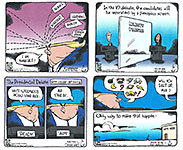
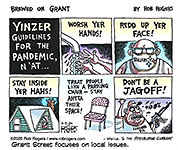
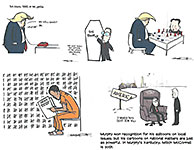
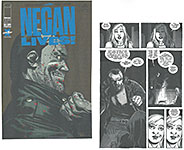
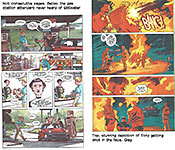
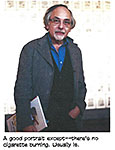

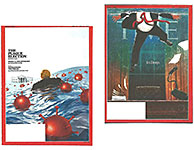
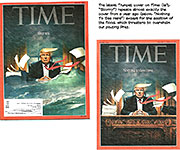

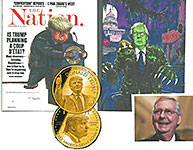


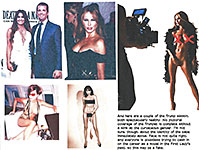
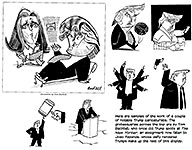
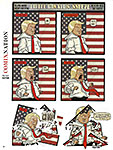
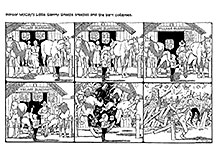
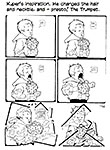
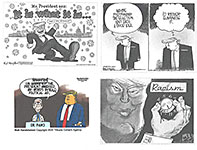
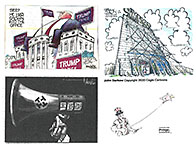
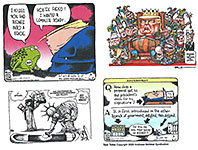
1.jpg)
1a.jpg)
2.jpg)
3.jpg)
4.jpg)
5.jpg)
6.jpg)
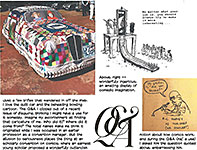
7.jpg)
8.jpg)
9.jpg)
10.jpg)
11.jpg)

12.jpg)
13.jpg)
14.jpg)
15.jpg)
1.jpg)
2.jpg)
3.jpg)
4.jpg)
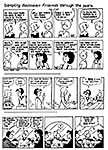
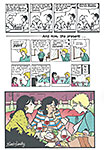
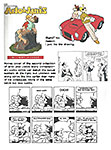
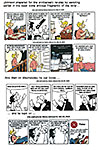
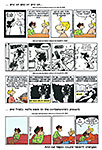
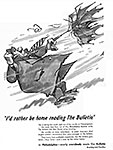
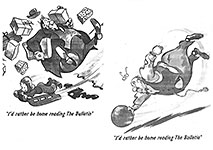
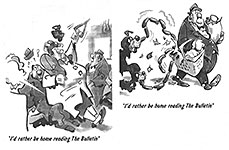
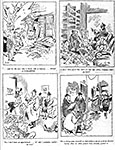
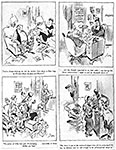
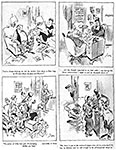
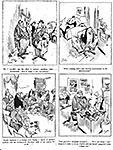
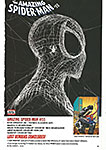
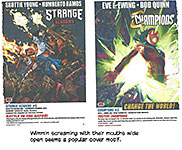

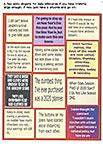
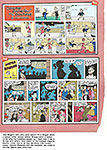
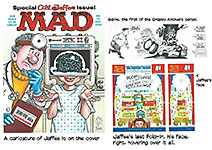
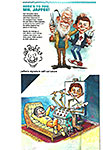
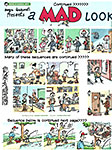
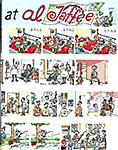
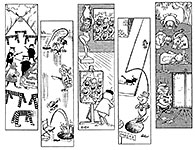
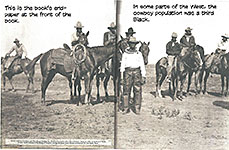
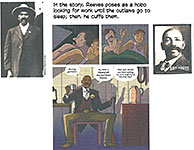
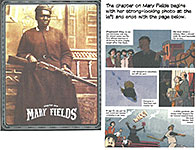
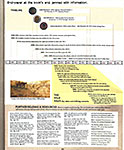

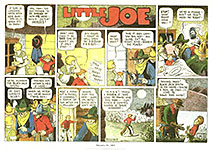
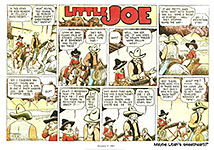
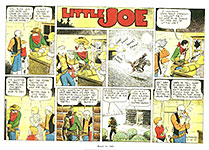
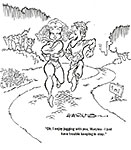
16.jpg)
